#a new shop coming to rue Victor Hugo…
Text
by unofficial
the journey
somewhere in ste-foy with Rafa 🐕 my dog
——-
a new shop coming to rue Victor Hugo…
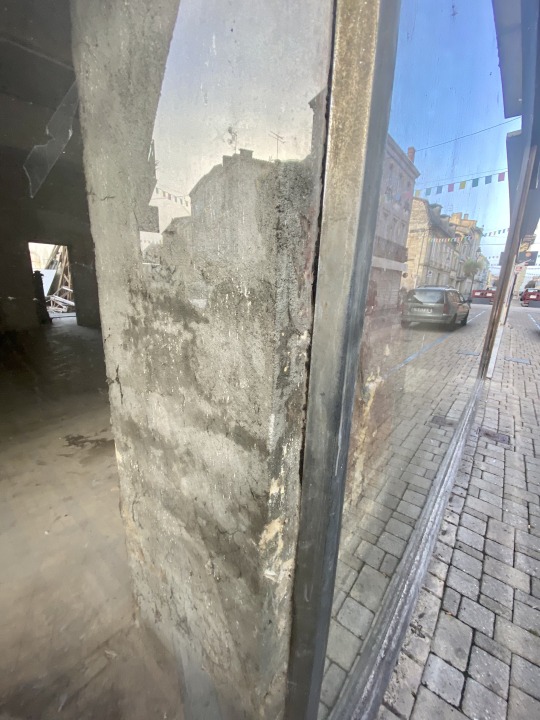
#frenchpsychiatrymuderedmycnut#by unofficial#the journey#somewhere in ste-foy with Rafa 🐕 my dog#a new shop coming to rue Victor Hugo…
3 notes
·
View notes
Text
Condé Nast Traveller: Where was 'Les Miserables' filmed?
As a stage and screen musical, Victor Hugo’s French-revolutionary epic took on a whole new life, so it’s a bold move for the BBC to reboot the beloved ‘Les Mis’ as a costume drama. Kudos, then, to this incarnation from master adapter Andrew Davies and a cast including Dominic West, Olivia Colman and David Oyelowo: unless you really love those tunes, this six-parter knocks the singing-and-dancing one into a cocked tricorne.
For producer Chris Carey, whose past credits range from dramas Apple Tree Yard and River to Mitchell and Webb comedy The Ambassadors, the secret was an under-appreciated corner of northern France. To create their early-19th-century France, he and his team looked at usual suspects Prague and Budapest. ‘They both do Paris very well,’ says Carey, ‘but for the variety of locations that Les Misérables has we just felt Belgium and northern France, the French Ardennes and then into the Belgian Ardennes, were the most authentic we could get.’
For the series’ opening scene, a panorama of the killing fields of Waterloo, this meant the authenticity was particularly high. ‘That was filmed about 15 miles from the battle, about 40 miles south of Brussels,’ he says. ‘We just found a field with a ditch and a friendly farmer and carved it up, then added 20,000 men and 500 dead horses with the help of a bit of computer-generated stuff.’
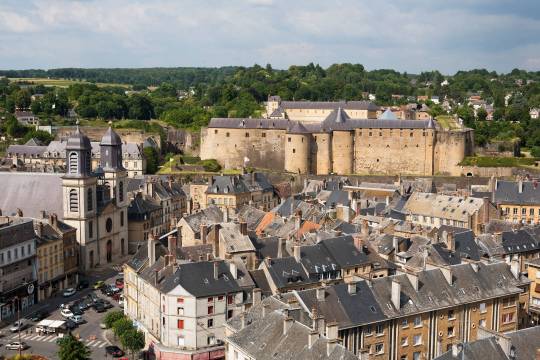
Scenes in the southern town of Toulon, where we first meet Valjean (West) suffering in the prison gangs, were recreated in Sedan (pictured above), on the French side – besides Brussels, the series’ most-used location. Though the interiors were shot in a studio, we see the prisoners emerging from the city’s Château Fort, one of the largest medieval forts in Europe (now a hotel), and the quarry where they labour is about five miles outside the town.
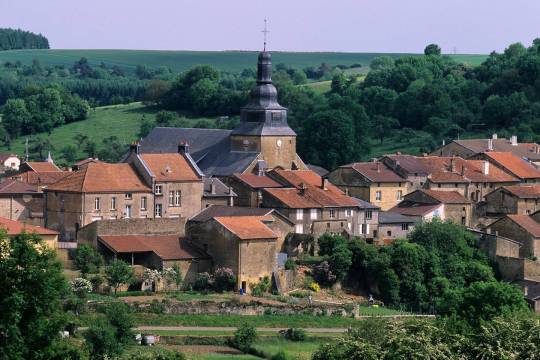
On his release, Valjean is taken in by the bishop in the hill town of Digne, which was filmed in Marville (pictured above), 35 miles south-east of Sedan. This is a miraculously preserved village – ‘It’s Lark Rise to Candleford in France,’ says Carey. ‘The fountain Valjean drinks from and the church in the square, even the bishop’s garden were real. All we did was put a bit of stuff down on the ground and remove some aerials in post-production.’

Valjean’s next port of call comes in Episode 2, with Montreuil-sur-Mer. This was filmed in Limbourg (pictured above), on the eastern borders of Belgium. ‘Again, it looks exactly as it does on the tin,’ says Carey. ‘It’s great because, even though it’s not far away, it’s got a very different feel from the summery heat of Digne – we filmed in the winter, so it’s cold and greys and blues.’

Episode 3 sees another key location, the inn run by the Thénardiers (Olivia Colman and Adeel Akhtar). For this, the exterior was shot at the Château de Meez, a riding school near Yvoir, about 50 miles from Brussels, and the interiors were in the Château d’Ecaussines-Lalaing (pictured above), a grand rococo castle nearby. While this venue provided the perfect period bar area – ‘We literally walked into the room and said, “That’s great,”’ – it also gave them a space that, with some redressing, doubled as the courtroom seen at the start of the same episode.

Of course, the real star of Les Misérables is Paris, a presence from the first episode. ‘Ours is actually an amalgam of a variety of places,’ says Carey. ‘There’s Brussels, a bit of Ghent (pictured above), a lot of Sedan, a bit of Huis in Belgium, the river in Namur. We went everywhere and pieced it all together with a bit of help from CGI.’
In Brussels, the house of Gillenormand (David Bradley) and Marius (Josh O’Connor) was filmed inside antique shop Costermans on Place du Grand Sablon. For the exteriors, they moved to Rue du Peuplier near Sainte Cathérine, with the church of St Sulpice played by St Jean Baptiste au Béguinage, a 17th-century Flemish baroque construction.
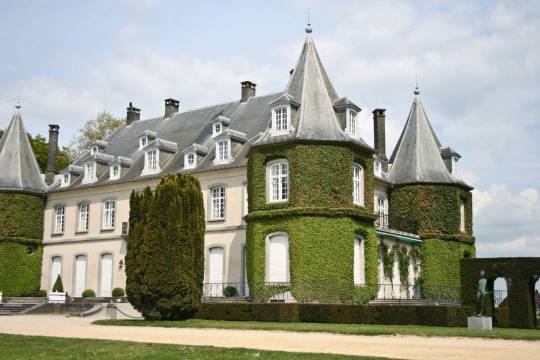
Brussels is also where we see Fontine (Lily Collins) on a romantic boating trip with her beau Felix (Johnny Flynn), or at least the village of La Hulpe just to the south, where the 19th-century neo-Renaissance château (pictured above) also provided the venue for their lunch. Ghent, to the north-west, was used for a busy street scene. ‘We turned a riverside there into a Parisian marketplace and dropped Notre Dame into the background with CG – no spire, because it was built without it,’ explains Carey. ‘We really wanted Paris to feel wide and open and epic, so we’d take over bridges or quaysides, where 100 feet around the camera would have the same essential architecture, and then fill in at the back with CGI.’
For the climax of the series, at the revolutionary barricades, they were back in Sedan. ‘That was in a real street, in the middle of the night, and they let us blow it up,’ says Carey, still not quite believing it. ‘It took a phenomenal amount of arrangement – and great patience on their part not to lose faith at two in the morning when we’re firing guns and shooting cannons and the locals are complaining.’
Tempers were assuaged by extra business at the pizza takeaway – ‘I think they did very well out of the 150 extra people in town’ – but Carey’s also returning in January to give the citoyens a special screening. He’s also spreading the word about his discovery: ‘It’s an amazing town, and a really beautiful and interesting region,’ he says. ‘That whole area of northern France is so gorgeous and visitors just don’t go there enough.’
Les Misérables is available on BBC iPlayer (x)
#les mis bbc#bbc les mis#articles#locations#condé nast traveller#sedan#Brussels#Limbourg#Ecaussinnes#marville#waterloo#Interviews#chris carey
11 notes
·
View notes
Text
In Brussels? Here are my top picks on what to do, see, drink, and eat
I am not going to claim to be an expert, but this winter I will be celebrating my 7th year in Europe’s Captial City—and I adore this city.
I have gone to hundreds of cities, I believe there is nothing quite like Brussels.
But it took me years to get here, and many tourists don’t immediately find it charming. And that’s ok. Because Brussels is small and too many tourists is not super good...and I am only partially joking.
It is a secret city. Non-obvious and full of delights.
Over the years, I have learned one or two things about Brussels, and today I present you with my list of top things to do, see, drink and eat. You can do all of this in 24hours.
My 10 favourite things to do in Brussels
Here we go!
1. Eat a waffle in the Grand Place.
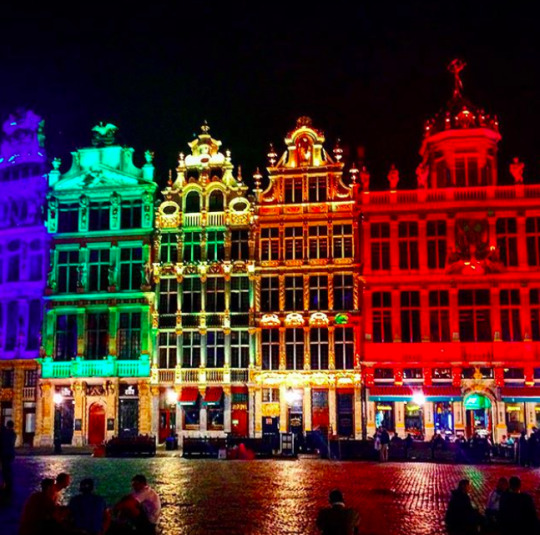
It is best to see the Grand Place at night first, then in the day after.
For my vegan friends: Go to The Sister’s Cafe for vegan waffles WITH vegan ice cream.
For my non-vegan friends: Go to Maison Dandoy—they are simply the best waffles in the city. There are two kinds Brussels (light and airy) and Leige (thick and cakey) so if you are with someone else, get one of each, and if you are alone, choose wisely!
Once, Victor Hugo, who wrote Les Miserables, lived in an apartment in the place. He said it is “a dazzling fantasy dreamed up by a poet, and realized by an architect.”. There is so much history I would love to share with you about it, but I’ll save that for another time. Just go an enjoy it. It is truly spectacular.
2. Walk from Park Royal to Park Cinquantenaire.
The whole walk takes about 35 minutes, and you will see three beautiful parks: Park Royal, Park Leopold, and Park Cinquantenaire, as well as the Royal Palace, the European Parliament, and the Triumphal Arch.
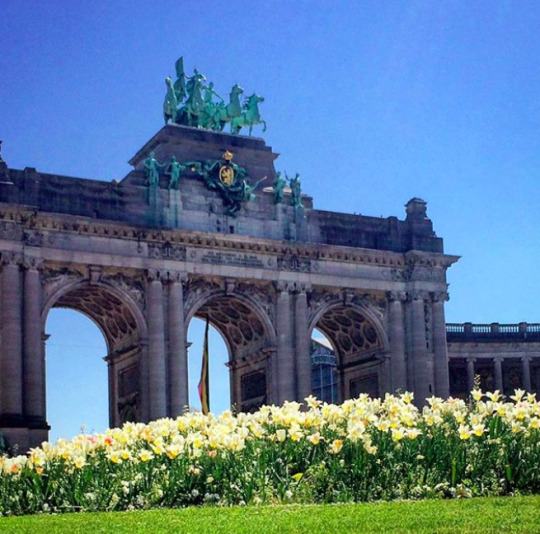
Its a much better way to spend your time than going to the Atomium—which will take 2-3 hours minimum and is ok, but really rather touristy.
3. Go and see the Palace of Justice at sunset
Or any time, but it is the best at sunset.
You can go to the grocery store and buy some drinks and snacks and sit up there to watch the sunset, it is chill and has a great view of the city skyline.
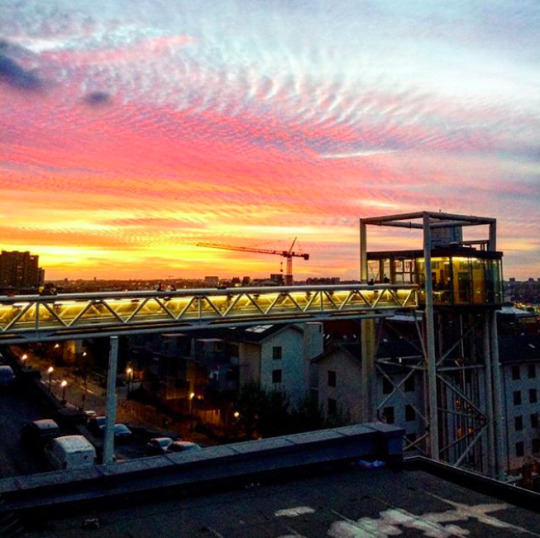
4. Eat chocolate at the Grand Sablon:
My top picks are
Frederic Blondeel
Wittamer
Pierre Marcolini
How it works: you buy the chocolate by weight, so choose 2-3 different pieces from each place. 3-4 chocolates should cost between €4-€7.
Usually, the people behind the counter are not very helpful, but I still ask for personal favourites and recommendations anyway.
Either way, you should always try the “Grand Cru”, this is the best the chocolatier thinks they can do. Yum is usually the result.
Plant-based buddies: most of the dark chocolate is vegan! But make sure you double check, because some of the other ingredients might not be, like caramel being made with butter, etc.
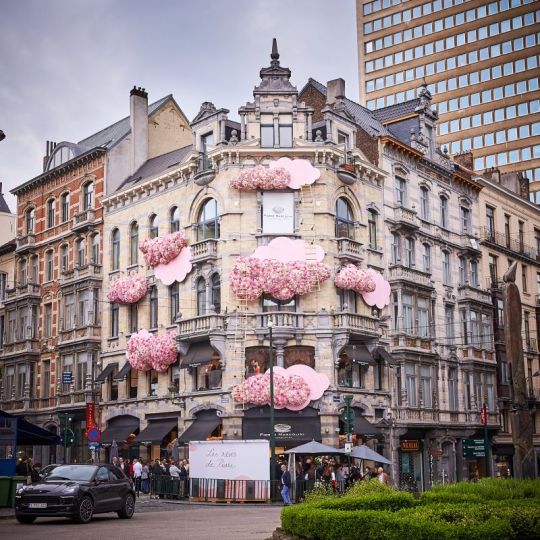
5. Go to the European History Museum in Park Leopold
It is free. And amazing.
One of the best and most interactive museums I have been to: it has great tech, tons of ways to get involved with the exhibits, and tells a fascinating story.
6. Go see our national monument, the Manneken Pis
Also... the Manneken Pis Museum. It is just up the street and guaranteed a right giggle.
7. Sit at the top of Mont des Art.
Best in the early evening. then walk through the garden. There is always a lot of animation and things going on, but it is also very relaxed.
Make sure you check out the architecture on Rue Montagne de la Cour, like the Musical Instruments Museum and the Old English Pharmacy.
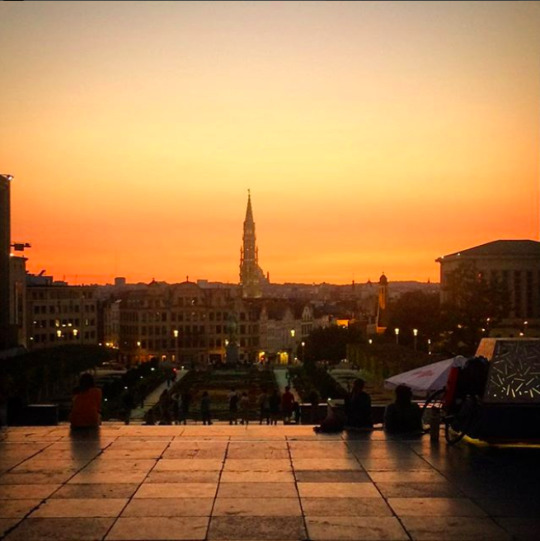
8. Do some unique shopping/browsing.
I am not personally big on buying loads of stuff, but these little streets are jammed packed with the unique and wonderful.
Here are my top picks:
Rue de Rollerbeek
Rue du Haute
the Royal Galleries (Actually, I have never bought anything here, but the buildings are amazing.)
9. Eat some fries.
I might be plant-based but I make an exception for the occasional frites treats, because they are the best in the world. There is no contest.
For the sauce: you can go:
Traditional with a dollop of Mayonnaise
Spicy with the Pili-pili (less spicy) or my favourite Samurai (more spicy).
Not spicy, but with a burst of flavour go with the Andalouse (which is kind of mayonnaise with tomato and basil) or Curry Ketchup (which is exactly what it sounds like.)
Aioli is another very popular sauce, but I find it too garlicky (but if you are into garlic, try it out. Just don’t try and kiss me after.)
Vegans + vegetarians: the frites definitely contain animal fat.
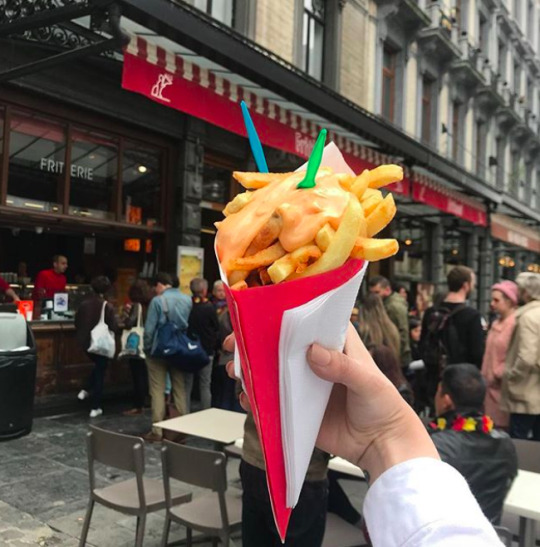
My top picks
Fritland right by the Grand Place
Friterie Saint-Josse
Frit Flagey
Which brings me to number 10! They are related.
In Brussels, there is a local phrase which goes “faire du gras” which translates to something like “lay down the fat” and means “eat something heavy”—and is good advice before you start drinking in Brussels. 2 strong beers on an empty stomach is almost a guarantee you will end up tripping on one of our many uneven, cobblestone roads.
10. Drink beer.
Also—the best in the world (Yes Germany, I have tried your beers, and I am sticking to what I said.)
God, this needs a whole other post. But you are only here for a short time, so let’s get into it.
First: where to drink.
These are my favourite watering holes and their locations.
Le Coq in front of Beurs: Classic Belgian pub, and very fairly priced. (ie. cheap)
Zebra in St.Gery: This old island is the best spot to drink and people watch after work and on the weekend.
Bar Llanes or Café Charbon on Marche du Charbon in front of the Notre-Dame de Bon Secours. They are beside each other.
Monks in Saint Catharine: a bit overpriced, but great selection and cool ambience.
The Brussels Beer Project Brewery by the canal: They are constantly creating new brews, and you can test out the new flavours, then vote on them, which is fun.
Le Barboteur Bierothèque in St.Josse: Amazing selection and very unpretentious. (But only good if you are in the neighbourhood, because it is pretty far from the city centre.)
Le Verschueren in St.Gilles: Sit with the cool, Belgian artists. Great people and good prices, but also only good if you are in the neighbourhood.)
Café Belga and L'Amère à Boire in Place Flagey: Really different atmospheres, but both are fun, although a little hipstery. Don’t make a special trip out to see them, but if you are in Flagey, they are great.
If you want to see some breathtaking architecture from the turn of the century and drink some rather overpriced beer, visit:
Le Cirio
Cafe Metropole
Mort Subite
There are 1150 Belgian beers, which is an overwhelming number.
Even if I had drank a new beer every other day since arriving, I still wouldn’t have tried them all. So don’t feel bad if you don’t know where to start.
Here is a quick and dirty guide to some of my favourites.
For something heavy that will get you drunk almost immediately, try the Trappist beers. There are only 6 breweries in the world, and the beer is brewed in the traditional style by monks! (Note: Proceed with caution)
Rochefort 10: Hold on to your hats, you are heading to drunk town on a smooth chocolate river.
Westmalle Tripel: This is a very good, bitter, mega strong beer.
Chimay Bleu: A sweet, dark, internationally-known bestseller! Stop at one though, it gives a vicious hangover after you’ve had 3.
For something unique only to Belgium, and is stupidly delicious, like a refreshing beer-lemonade, try the gueuze:
Gueuze Boon: This is my all time favourite drink in Belgium. Possibly the world.
Oud Beersel: Also a hella delicious gueuze, but brewed in the old style, without wheat.
Mort Subite Kriek: a gueuze sweetened with cherries. I can only have one of these at a time because they are intense, but a good occasional treat.
If you are not even sure you like beer, but are in Brussels so what the hell:
Faro Lambic: light and sweet and way too drinkable. Like juice.
Tripel Karmeliet: a delicious, well-balanced crowd pleaser
Chouffe: very light tasting, but watch out! Strong in effect.
Saison Dupont: a very popular, classic Belgian beer.
You are not a fan of stong or heavy beers, and really want a pils (once again Germans, I am looking at you.) we have three very popular pilsner brands that you’ll be able to get just about anywhere.
Jupiler: mildly sweet, and the most popular beer in Belgium (especially with sports fans).
Maes: a little closer to a lager than a pils, but if I am going to drink a pils, I choose this one.
Stella Artois: This is Belgian, not Italian beer! It is a pretty easy drinking beer and also available just about everywhere....including the country you are coming from.
Like Stella Artois, I have a tendency to tell guests to avoid Duvel and Leffe—while they are fine beer brands, they are available around the world, and you will probably be able to find them in your home country, although perhaps for a much higher price.

There is a lot more I could say about Brussels, but I hope this is enough to get you started! See you soon.
Want to read stuff I’ve written about Belgium?
Here are a few other posts about life in Europe’s Capital.
21 Reasons to love Belgium
20 Canadian/British Habits I Lost When I Moved To Brussels
An Adult Tour of the Beaux Art Museum
Part 1: The history of Belgium
Part 2: Because art is awesome
I am safe: A post about what it felt like to be in Brussels after the Brussels Attacks.
4 notes
·
View notes
Text
(for @qu33n0f3agl3s , who asked for it, and anyone else who might want a somewhat broad-strokes guide to where a fic writer might want to put an aspiring young creative type in canon era to make connections. Anyone with specifics or other researched suggestions to add, please do! I might be able to provide more detailed answers for a more specific question, too, but this was for a very broad ask, so it’s a very broad answer.)
Just where does a young hopeful artist or writer looking to make a Romantically spelled name for themselves go in late 1820s- early 1830s Paris?
It’s going to depend a little on exactly when you’re looking to join the scene!
First, you’re going to want to set up your own base of operations--the coffee shop where you go to use the free wifi (water) and meet other starving, aspiring young creative types. If you’re an artist or sculptor, maybe you’ll be part of an atelier; if you’re a young architect , probably you’re in with some firm or “house”.
If you want to get into the theater crowd, well, go to the theater! Buying some actors or writers a round or two of drinks is a good way to get your foot in the door and start making acquaintances. Aspiring playwright , actor, or anything else theatrical, you can do worse than get a reputation as a team player, after all...
Writers...you’re in the coffee shop. But that’s okay, because pretty much everyone is, it’s Café Culture time! Sooner or later the artists and actors you might be trying to meet will be in a café too. Find a nice dive in the Latin Quarter, maybe that “Graziano’s” joint. (If you’re a fic writer, and working on the fly, feel free to invent the name of some hole-in-the-wall-- after all, Hugo did!) . And then keep an eye out for someone who can get you into one of these places!:
mid-to-late 1820s:
The first Place To Be is Charles Nodier’s Cenacle. All the big names hang out there! Nodier himself , Hugo, de Vigny, Dumas, Saint Beuve, Lamartine, Musset, the Deverias, just everyone. It’s Royalist and a bit serious--these are professionals still trying to work within the system they’ve inherited at this point-- but this is where ties are being made and plans are starting to form for the next phase of the movement. Note that you will need the support, experience and connections these people can get you if you want a real solid career right now-- these are people who know how to work with the censors, get the backing of managers, deal with publishers and galleries, and generally do all the parts of having a creative career that aren’t just writing or making art.
Mid 1829- Early 1830
Holy smokes, why aren’t you at Victor Hugo’s house?? Don’t you know there’s a War of The Words going on?? Look, it’s right here, this little apartment! Go and say you’re there to join the Romantic Army!
If you don’t have the nerve, or if Saint-Beuve’s blocking the door, see if you can find one of Hugo’s Lieutenants, Petrus Borel or Gerard de Nerval. They’re usually around somewhere. The artist’s ateliers are a good place to meet up with them, and the sculptors-- especially if you can find this DuSeigneur guy. If you’re in the theater--like, actively working backstage-- you might try talking to Dumas or Harrel.
But you’ve definitely gotta get into Hugo’s. The plans for Hernani are The Thing going on in the Romanticist community. The old Cenacle still meets, but Nodier’s influence is on the wane, and the radical voices in the movement are making themselves heard more and more...
1830-1835
If you’re looking to get your fannish swoon on, or you’re an established creator or member of the Romanticist community already, you still want to head to Hugo’s house. It’s become a bit of a constant salon, and it’s a great place to meet the famous, the nearly-famous, and a few fading stars.
Nodier’s Cenacle is still meeting sometimes, but even he’s aware that his era as the center of The Scene is fading; the Hot New Talents are rallying around Hugo, and, increasingly, under their own banners.
If you’re not so well known (but you will be one day! You’ll show them all!) then you want to get in and start making alliances with the Petit Cenacle/ Bouzingos/ Jeunes France!
There’s also a woman you’re going to hear mentioned a lot, Delphin Girardin...but you won’t be seeing her until you’ve started to make a name for yourself. Her salons are a bit less open to all, but still very sociable, super Romantic...and maybe a little bit republican...
1835-1843
There’s two Big Places to Be, right now:
- For those who really want to get starstruck, there's still Hugo's house--his new place, where he moved after those Classicist vandals, and then that awful business with Saint Beuve. Now it's even more of a permanent salon; when Hugo's there, anyway. Dumas, de Vigny, even sometimes Nodier, still-- all the big names will be by at some time. This is a great place to be making connections, if you can keep up.
If the Great Master of Romanticism isn't in, Théophile Gautier is right next door, at his family's place. He's almost always friendly to new young artistic types looking to get into the Paris scene, and he and the friends he's hosting on any night may be a little less intimidating.
There's also the Rue du Doyenne! That's where Camille Rogier, Arsene Houssaye, and Gerard de Nerval live...often with Theo Gautier, who from this point on is sort of an omnipresent friendly spirit of the Romantic scene. Their parties aren't as lavish or well-stocked as Hugo's , but they're a lot more accessible and you don't have to worry about looking down on your luck. A LOT less intimidating than Hugo's star-spangled parties-- though some people here are starting to make serious Names for themselves, too.
Besides all these places, there is a constant churn of journals and magazines over these years that take essays and stories and naturally have their offices open to writers and artists looking to mail or deliver a submission. Making up an artsy journal title as a place for your writer or illustrator to hang out or meet people is totally defensible; the actual papers are going to be a lot more specific of course, but you might consider Le Monde Dramatique, Le Corsair,La Presse, or L’Artiste as actual-world options depending on era.
post-1843:
Romanticism isn’t really the New Rising Movement anymore; not only are even the last of the last waves growing up and fairly established (if they’ve survived at all) the failure of Les Burgraves in 1843 and the increasing censorship of the July Monarchy have pretty well ended the push for the excesses and social statements of Romanticism in its heydey. Established creators like Hugo, Dumas, Sand and Gautier will keep the Romantic style around for decades to come; but the Paris arts scene is by now a more general thing, with lots of rising “schools” mixing in a general French Bohemia. As such, this guide ends here, and leaves later explorations to another source.
#long post#sorry it's so late#Actual Romantics in Fictional Paris#sorry for the Long Post but#it took this long to make it this brief >_<
32 notes
·
View notes
Text
in which i consult the 1727 map of paris and discover the #fakenews of 1826
So I’ve been reading Les Misérables off and on, but I have a tendency to put it aside when I hit one of Hugo’s famous digressions. I’m determined to get through the book, though, and I decided -- inspired by the hilarious and seemingly-defunct (?) tumblr Read the Brick -- to read at least a chapter each day and blog about it as a means of holding myself accountable.
I’m not nearly as funny as Read the Brick’s writer, so my recaps will probably have fewer gifs and more nerding out about french language/history. Sorry. :/
First entry below, or read it on my blog.
***
So it's 2017 and I'm reading a novel published in 1862 and set in 1817 and Victor Hugo wants me to go back even farther and find a 1727 map of Paris?
This is typical Victor. Fortunately, we have the internet in 2017. This one's for you, Hugo:
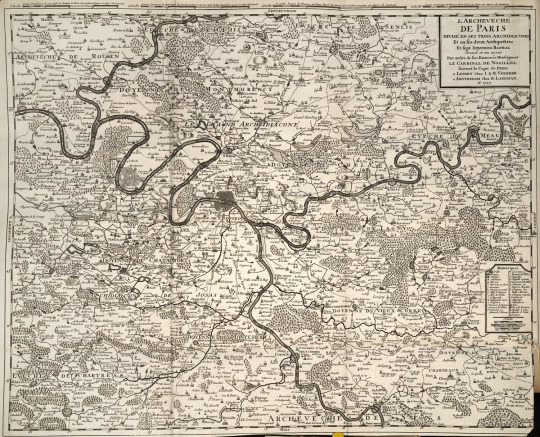
Map of Paris circa 1727 from Botanicon parisiense by Sébastien Vaillant. Found here.
A quick summary of where we are, since I'm picking up in the middle of the book:
Our protagonist and reformed ex-convict Jean Valjean is in hiding. He was originally sentenced to 5 years in prison for stealing a loaf of bread, but that sentence was lengthened to 19 years after multiple escape attempts. Valjean violated his parole and assumed a new identity, becoming the beloved mayor of a French town and helping out a prostitute who was just a single mother desperately trying to raise money to send to her child, who was living with an innkeeper in another town. Then the town's police inspector and former prison guard Javert comes to Valjean acting extremely sulky and demanding he be dismissed. Javert explained to the mayor that he was about to expose him as an ex-convict named Jean Valjean, but the "real" Jean Valjean had now been arrested and was going to trial. Valjean-in-disguise refuses to dismiss Javert, wrestles with his conscious for a long time, then outs himself as the actual Valjean. Meanwhile, the prostitute dies and Valjean promises to help her child, but a vindicated Javert re-arrests him. Valjean manages to fake his own death and escape prison again, then goes to check in on the prostitute's daughter. Turns out the girl, Cosette, has been treated horribly, so he "buys" her from the innkeepers and starts living with her in the slummy outskirts of Paris. Things were going ok until some people in his neighborhood started getting suspicious and Valjean starts getting paranoid that he's being followed. So one night, he takes little Cosette (she's, like, 7 or so years old) and all his money (he has a ton of money, btw, long story involving beads that Hugo will tell you all about) and sets off in the dark toward the center of Paris, not really sure where he's going but knowing that he can't go back. He then realizes four policemen are following them, and recognizes the face of the lead policeman in the moonlight.
Surprise! It's Javert.
And now here we are, being told to look at this old map of Paris.
Valjean has crossed the Pont d'Austerlitz bridge and is now carrying Cosette on his shoulders and keeping in the shadows as he navigates the streets of a nighttime Paris.
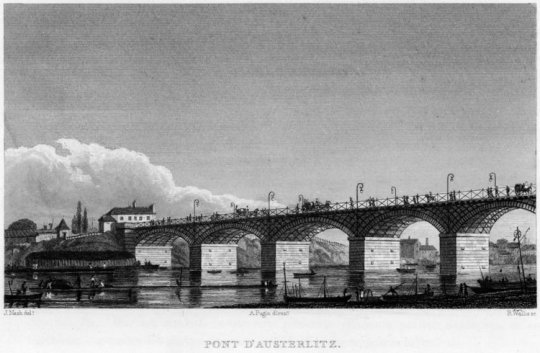
Pont d'Austerlitz in 1831, a public domain image available from the Brown University Library under the digital ID 1093026131948250.
But Valjean ends up at the end of a street with two options: to turn right, where a lane lined by sheds and storehouses goes a short distance and comes to a dead end at a high wall, or to turn left, where an open-ended alley leads to a main thoroughfare. He's about to turn left when he notices that a silent policeman is guarding the intersection with the main thoroughfare.
This all brings us to a very Victor Hugo-esque writing decision: Our hero is trapped, with police behind him and ahead of him. Tension is high. What happens next? Well, we won't find out until Hugo has given us a little history lesson on the Parisian location where Valjean is standing/panicking.
Perhaps the most infuriating thing about this is that there was never any neighborhood called Petit-Picpus, at least according to the internet, although the location Hugo is describing seems real enough to forgive him for that.
(Also very real, and very grisly, is the nearby Cimètiere de Picpus, where the headless bodies more than a thousand guillotine victims are buried.)
This is how Hugo describes our imaginary Petit-Picpus neighborhood:
Petit-Picpus ... had the almost monastic appearance of a Spanish town. The roads were rarely paved, the streets not much built up. Apart from the two or three streets we are going to talk about, it was all blank walls and desolation. Not one shop, not one vehicle, only the occasional lighted candle here and there at the windows, and all light extinguished after 10 o'clock. Gardens, convents, yards, allotments, the odd low-built house, and solid walls as high as the houses.
Now we get to the reason the chapter title told us to refer to the 1727 map: Victor claims Petit-Picpus is "quite clearly marked" on such a map, which it is not, because it's not real.
Dammit, Victor.
Oh, wait. We're not here to discuss fictional, 18th century Parisian neighborhoods. There's a lovable ex-convict trapped in alley! What's going on with that?
He considered Cul-de-Sac Genrot. That way: blocked. He considered Petite-Rue-Picpus. That way: guarded. He saw a dark figure standing out, black, against the white pavement bathed in moonlight. To go forward was to run into that man. To go back was to run straight into Javert. Jean Valjean felt caught in a slowly tightening net. He looked up to heaven in despair.
Here’s an approximate look at where things stand, using a modern map of Paris:
Hugo digression count so far: 1.
Tomorrow: II.V.IV Fumbling for a Way Out.
9 notes
·
View notes
Photo
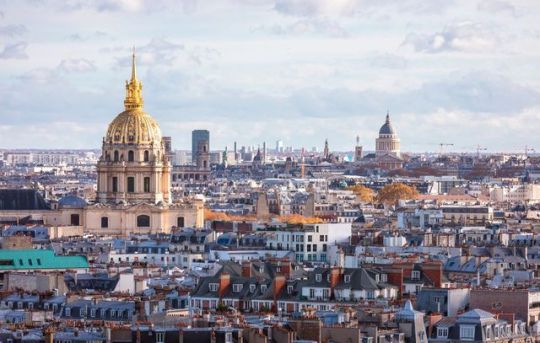
Full text write on https://easy-travel.pw/top-15-monuments-and-historic-sites-in-paris/france/
Top 15 Monuments and Historic Sites in Paris
01 of 16
Monuments Marking Paris’ Rich History
kiszon pascal / Getty Images
Paris is a city with a rich history that stretches back to the third century B.C. It is no surprise, then, that important Paris monuments are so numerous, breathtaking, and varied in terms of period and architectural style. From Roman-era ruins to post-World War II memorials, these famous sites and monuments in the City of Light are essential keys to understanding the city's elaborate and complicated past.
Before you go, also check out which are the 10 most visited tourist attractions and top 10 museums in Paris. Make a plan to visit those sites that appeal to you most.
Continue to 2 of 16 below.
02 of 16
Notre-Dame Cathedral
Ag photographe/Moment/Getty Images
Dating to the 12th century, Notre Dame dramatically towers alongside the banks of the Seine River, beckoning all to come to visit. It's simply breathtaking, with its intricate Gothic architectural details that took workers over a century to complete. Other stunning details are its flying buttresses; its famed bell tower from which one can still imagine Hugo's Quasimodo carrying out his duties; the scary and humorous gargoyles; and the stained-glass rose window inside. If you have extra time, make sure to visit the archaeological crypt at Notre Dame to learn more about the history of its construction and other fascinating elements.
Continue to 3 of 16 below.
03 of 16
Eiffel Tower
Aurelien Meunier/Getty Images News
When one of the world's most famous landmarks was presented as part of the 1889 World Exposition in Paris, many decried it as an eyesore on the city's horizon and demanded its removal. Who would have thought then, that the Eiffel Tower would become such an enduring and beloved icon of the City of Light? Before you go, learn the about the Eiffel Tower's interesting facts.
If you can, avoid visiting at peak hours and on weekends, so you can make the most of your visit and really enjoy the views from the top. The best times are just after it first opens and in the evenings.
Continue to 4 of 16 below.
04 of 16
The Louvre Palace and Museum
Harald Sund/The Image Bank/Getty Images
When most think of the Louvre, it's thought of as a museum, but it was a fortress and palace long before it became a world center for art. The palace is a testament to its rich history spanning from the medieval period to the present. Visiting the Louvre's Medieval foundation is fascinating. The adjacent Tuileries Gardens are perfect for a stroll before or after your visit to the museum. There is so much to see at the Louvre, don't try to pack it into just one day.
Continue to 5 of 16 below.
05 of 16
Arc de Triomphe
Pascal Ducept/Hemis.fr/Getty
Looming 164 feet above the bustling traffic circle at the head of the Avenue des Champs-Elysees, the Arc de Triomphe seems to exemplify pomp and circumstance. You just do not get structures like these anymore. The arch is an icon of imperial France under Napoleon I and is a testament to a time when European leaders felt no shame in erecting massive structures in the service of their equally massive egos. Many do not bother to take the tour to the top, but the views over the elegant avenue stretching all the way to the Place de la Concorde, through the Tuileries, and on to the Louvre is more than worthwhile.
Continue to 6 of 16 below.
06 of 16
The Sorbonne and the Latin Quarter
Joachim Hiltmann/Getty Images
You can almost picture it: a student roaming the halls of the Sorbonne with dusty old books clutched underarm, or, that same student sipping cafe perched in its old square situated in the St-Michel neighborhood in the Latin Quarter. One of Europe's oldest and most esteemed universities, the Sorbonne was founded in 1257, but studies here were initially exclusively theological. This is because, during the Medieval period, scholarship was almost exclusively the domain of monks, scribes, and other figures attached to the Catholic Church. Of course, in later centuries, the Sorbonne would go on to help produce some of Europe's most famous minds, before becoming a site of revolt during the 1968 student movements. After you have had your fill of the school, take a step into the Old Latin Quarter: the Rue Mouffetard district.
Continue to 7 of 16 below.
07 of 16
The Pantheon
CALLE MONTES / Getty Images
The Pantheon is a neoclassical-style mausoleum where many of France's great minds like Voltaire, Rousseau, and Victor Hugo are buried. It was built between 1758 and 1790. From the Pantheon, a distant Eiffel Tower can be seen. Stop by the Pantheon during a stroll in the Latin Quarter.
Continue to 8 of 16 below.
08 of 16
Pere Lachaise Cemetery
Graham Monro/Gm photographics/Getty Images
There are many beautiful cemeteries within Paris, Pere Lachaise is one of most popular and loveliest. In addition to hosting the graves of famous souls from Oscar Wilde, playwright Moliere, and Jim Morrison of the Doors, the cemetery is simply a gorgeous place to stroll and meditate. There are also important war memorials on the site that pay tribute to the many who perished in conflicts and wars.
Continue to 9 of 16 below.
09 of 16
La Sainte Chapelle
tmal / Pixabay
Not far from Notre Dame on the Ile de la Cite looms another pinnacle of gothic architecture. Sainte Chapelle was erected in the mid-13th century by King Louis IX. The cathedral features some of the period's best-conceived stained glass, housing a total of 15 glass panels and a prominent large window, whose colors remain surprisingly vibrant. Wall paintings and elaborate carvings place more emphasis on the stunning Medieval beauty of Sainte Chapelle.
To extend your visit, you can tour the adjoining Conciergerie, part of the former Medieval royal palace. It was used as a prison during the Revolutionary “Terror.” Queen Marie Antoinette spent her last days there before being executed.
Continue to 10 of 16 below.
10 of 16
Opera Garnier
Gabrielle & Michel Therin-Weise / robertharding / Getty Images
Seating 2,200 people, the imposing Opera Garnier in Paris—also known as the Palais Garnier or simply the Paris Opera—is an architectural treasure and essential spot for the city's ballet and classical music scene.
Designed by Charles Garnier and inaugurated in 1875 as the Academie Nationale de Musique Theatre de l'Opera (National Academy of Music Opera Theater), the neo-baroque style building is the home of the Paris ballet. The city's official opera company relocated to the starkly contemporary Opera Bastille in 1989.
Continue to 11 of 16 below.
11 of 16
Hotel de Cluny and Roman Baths
12019 / Pixabay
The Hotel de Cluny is a Medieval residence that now houses the National Medieval Museum. The famous tapestry, “The Lady and the Unicorn,” is displayed there. Situated in the historic Latin Quarter, not far from the Sorbonne, the Hotel de Cluny boasts a Medieval-style aromatic garden that provides a pleasant spot for a stroll or for reading on a bench in the spring or summer.
The ruins of Roman Empire thermal baths can also be seen on-site. One of the museum's rooms, the tepidarium, was originally the “warm room” from the baths.
Continue to 12 of 16 below.
12 of 16
Palais Royal Gardens
Nico De Pasquale Photography / Getty Images
Situated between the Louvre and the Opera Garnier is a Renaissance-style palace that was once the residence of the Cardinal Richelieu. Today, occupied by luxury boutiques and restaurants, as well as several government offices, the Palais Royal was for centuries the center of royal amusement. French playwright Moliere occupied a theater that once stood here with his troupe. It has since burned down, twice.
The stately palais and accompanying gardens are a very pleasant place for a stroll, cafe, or whirl around high-end shops, while Daniel Buren's quirky modern sculpture adds an interesting contrast to the old-world charm.
Continue to 13 of 16 below.
13 of 16
Hotel de Ville (City Hall)
Santiago Urquijo / Getty Images
Yet another “hotel” that is most certainly not a hotel in the English sense, Paris' Renaissance-style City Hall sits proudly in the center of Paris. It was built in 1873 on the vast plaza that was once called “Place de la Greve,” a site notorious for gory public executions during the Medieval period.
Today, Hôtel de Ville hosts events throughout the year like free exhibits, concerts during the summer, and ice-skating during the winter months. It can be a glorious sight in its lit evening guise.
Continue to 14 of 16 below.
14 of 16
Les Invalides
Juan Carlos Cordovez-Mantilla / Wikimedia Commons / CC BY-SA 3.0
This vast complex was built as a hospital and convalescent home for injured soldiers under the reign of Louis XIV. Part of Les Invalides maintains this role today, but it is most famous for housing the tomb of Napoleon Bonaparte. The on-site Musée de l'Armée (Army Museum) boasts a vast collection of military artifacts and an elaborate armory.
Continue to 15 of 16 below.
15 of 16
Saint Denis Basilica
Christophe Lehenaff / Getty Images
Just north of Paris in a working-class suburb is one of France's oldest sites of Christian worship and its most famous abbey—a burial place for 43 kings and 32 queens. The Saint Denis Basilica, whose current edifice was built sometime between the 11th and 12th centuries, served as a royal burial site from as early as the fifth century. With its sculpted tombs and flamboyant Gothic details, this often-overlooked gem is worth a trip outside the city limits.
Continue to 16 of 16 below.
16 of 16
Deportation Memorial
Jon Boyes / Getty Images
This sober memorial pays tribute to the 200,000 people (mostly Jews) who were deported to Nazi death camps from France during World War II. Erected in 1962 on the banks of the Seine (across from Notre Dame) and on the site of a former morgue, the Deportation Memorial was designed by architect G.H. Pingusson to evoke a sense of claustrophobia and despair.
One part of the memorial features an “eternal flame of hope” and an inscription reading the following: “Dedicated to the living memory of the 200,000 French deportees sleeping in the night and the fog, exterminated in the Nazi concentration camps.”
Nearby, you can visit the Paris Museum of Jewish Arts and History.
#travel #airlinetickets #airtickets #cheapairfare #planetickets #travelinsurance #travelquotes #travelblogger #traveller #travelling #travelocity #travelodge #vacation
0 notes
Text
Mont-St-Michel and St-Malo
31/03/2016: The weather for today. Something like yesterday. Overcast and cold with a 20 knot breeze. Up to 11 degrees today.
Today we visited the 10th century Gothic abbey Mont Saint-Michel, built by Benedictine monks and perched eighty odd metres high on a rocky isle on the border of Brittany and Normandy.
We were out and about by nine and with all aboard we set the navigation system to our destination and were guided up from the river, back over the bridge and out of Dinan.
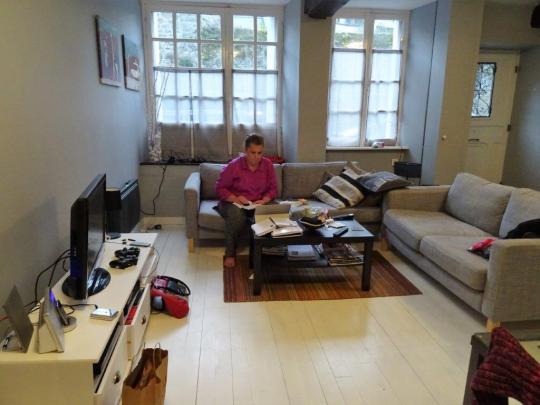
Final plans before departure
The distance to the abbey was around 60 kilometres but travel time was over an hour so we guessed that the roads would be less than flash. Setting the GPS to the shortest route was the right move as it was only ten minutes slower than the fastest route and once over the bridge and having traveled along Rue du Lion d'Or, we ended up leaving the area via road D795. As with our previous experiences, the narrow roads were lined with typically small French villages displaying charismatic stone cottages whose façades combined to form delineation between road and residence.
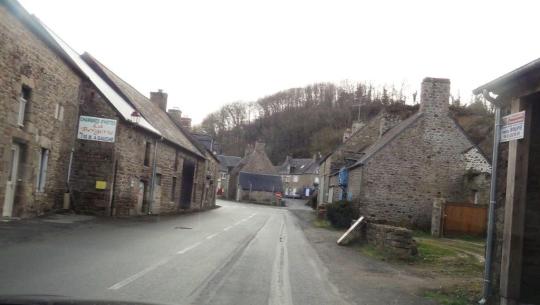
Travelling through La Poultière
A few kilometres from our destination the hazy silhouette of le Mont appeared but a better view would be had from higher up. At the next town, Le Bas du Palais, we turned up winding road to the plateau above and after reaching the top found ourselves in a small park in a village called Roz-sur-Couesnon with great views over the lovely flat countryside leading to Mont Saint-Michel.
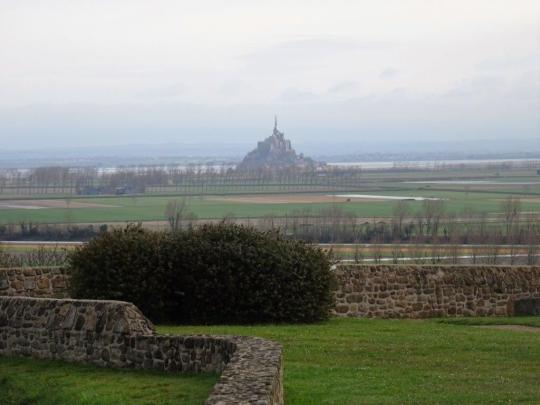
View from Roz-sur-Couesnon, Mont-St-Michel afar
The countryside was so lovely in fact that when we descended back into the fields, we were shown around by progressing to every dead end that the navigation system recommended. Through narrow farm road after farm road we finally switched it off and used our instincts. Just head anywhere as long as it’s in the right general direction. Not long after and we were crossing le Couesnon and entering the carpark provided these days for visitors to le Mont.
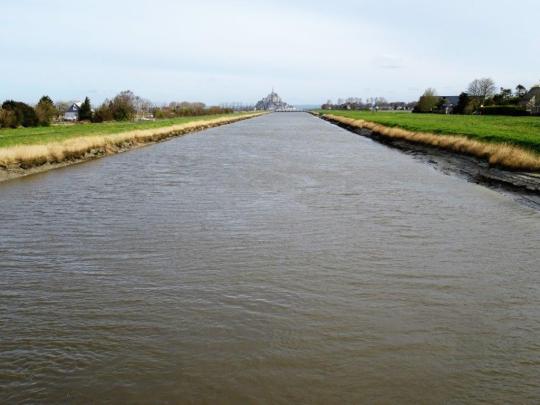
Looking down le Couesnon toward Mont-St-Michel
The carpark and connecting bridge are recent additions to the area, replacing the one hundred and thirty-year-old causeway that used to provide access and allow vehicles to park on the sand at the base of Mont St-Michel, occasionally succumbing to the fast and fickle tides as well as the quick sand.
Once well and truly Breton, Mont St-Michel found itself the centre of attention after the Norman annexation of the Cotentin Peninsula during the tenth century placed the island on the frontier. The traditional border became the river which continually silted up and changed course, eventually placing the mount on Norman soil leading to the Breton saying,
“Le Couesnon a fait film cy est le Mont en Normandie” or
“The Couesnon in his madness would put the Mount in Normandy.”
The actual border is about four kilometres west of the mount.
The variation in the tides is significant, over four metres and posed much danger to the medieval pilgrims trying to access the place. Described by the French poet Victor Hugo as “à la vitesse d'un cheval au galop” or at the speed of a galloping horse, the tidal system actually delivers the water at a little less than that. Around four kilometres per hour or walking pace.
The nineteenth century causeway and channelling of the river, although creating safer passage to the mount, created disruption to the natural flow of the river and flushing of the tides resulting in many acres of salt marsh increasing annually and encroaching on the isle. This would have seen Mont St-Michel surrounded by grass within thirty years. These salt marsh fields are the same that feed the local sheep and produce the local specialty, agneau de pré-salé (lamb salt meadow) if one can afford it (apparently).
By 2009 the new carpark and road were commenced with the bridge being completed by 2014. Sluice gates replaced the old dam and control flow from the river. The total construction cost over €200 million and was officially opened by President François Hollande.
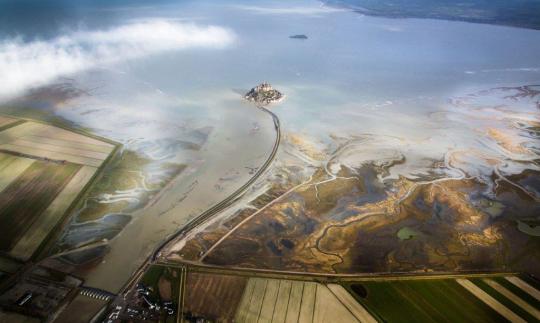
Aerial shot of the completed works http://www.sbp.de
Today one can only park and ride via bus or horse and cart, or if energetic, park and walk. Car parking provisions were conveniently located nearly three kilometres from the front gate of Mont St-Michel which gave us plenty of opportunity get some nice photos.
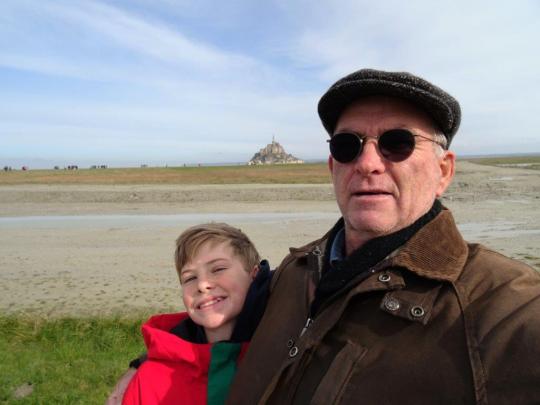
Two and a half kilometres to go
A pleasant if not chilly stroll across the causeway and bridge was ahead of us and as we neared our destination, although enjoying the exercise and fresh air, we watched the bus loads of tourists pass by (including Jo and Soph) and wished we were led into temptation and were on there with them. The beauty of the surrounds however, numbed us to the cold and put strength in our legs and we soldiered on to the end.

The Abbey of Mont St-Michel
Three quarters of an hour of walking and we were almost there. Only a few hundred metres away. The shuttle buses were a unique design. As there was no turning area at the terminus a driver’s station was located at each end so that when it was time to return, the driver just walked from one end of the bus to the other and away they went. We were all reunited and looking up in awe. Not only at the structure itself, but the effort that lay ahead scaling the stairs to the top.
Enough said. We headed straight toward Porte de l'Avancée, the first of three gates and into the walls of the town and after passing through the gate we found ourselves in the courtyard of Corps de Garde des Bourgeois, a sixteenth century guardhouse which now housed the information centre. Immediately to our right was the second gate, Porte du Boulevard which in turn led to the main and most fortified gate, Porte du Roi, with portcullis and moat spanned by a draw bridge with open arms inviting us in to the town’s main street, le Grande rue.

Porte de l'Avancée and the effort that lay ahead.
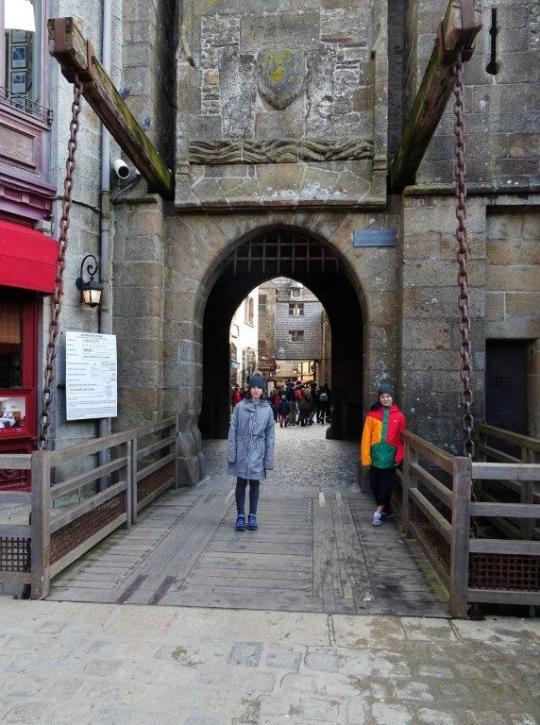
Welcoming arms of Porte du Roi
According to our brochures, the history of Mont St-Michel dates back to 708 when the Bishop of Avranches built a sanctuary on top of the then Mont-Tombe in honour of the Archangel Saint Michael who wasn’t or isn’t a saint at all. Just an angel, or rather an archangel, he was the leader of the army of god with a primary responsibility to combat Satan.
Not long after the sanctuary was built it became a major focus of pilgrims and by sometime in the tenth century the Benedictine monks had built the abbey and had moved in, all the while with the village growing below its walls. Just over 100 years later William the Conqueror left his Rouen palace and crossed the River Couesnon near Mont St-Michel on his way to attacking Duke Conan II of Brittany at the Dol.

Mont St-Michel by Matthäus Merian. Printed in 1657
As with the besieging of Dinan, the Bayeux Tapestry also depicts the journey and Harold Earl of Wessex rescuing Norman soldiers that are sinking in the quicksand.
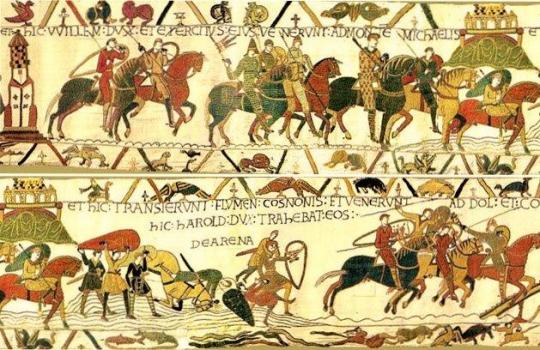
HIC VVILLEM DUX ET EXERCITUS EIUS VENERUNT AD MONTE(M) MICHAELIS ET HIC TRANSIERUNT FLUMEN COSNONIS ET VENERUNT AD DOL HIC HAROLD DUX TRAHEBAT EOS DE ARENA
Here Duke William and his army have come to Mont St. Michel and they crossed River Couesnon and they have come to Dol. Here Duke Harold pulled them from quicksand

Some of the sands that may have bothered William and Harold
Through Porte du Roi and up the considerable incline of le Grande rue. The street was no less than a cobbled laneway lined with restaurants, boutiques and souvenir shops. Not much more, a few hotels and the odd museum maybe. Navigating from shop to shop, side to side was difficult due to the narrowness of the street and the density of tourists. Some shops were of interest, others not, and in no time we were as far as we could go up le Grande rue. Not because we were at the end but due to construction blocking off the upper reaches.
We could however, reach the small village church, Église St-Pierre which would have been easy to miss had the road block not had been there. The church was proportional to the village, small. Pushing through the people blocking the entrance found us in a quaint little church. It is alluded to as an edifice but small and imposing as opposed to large. Sitting in the shadows of the abbey above, it is dwarfed, but as an edifice to the village below that it has served for almost five hundred years, the definition may be a more pertinent portrayal. So it’s a small edifice consecrated to St-Pierre, the patron saint of fishermen and constructed between the fifteenth and sixteenth centuries. More likely when fishermen were a major trade in the area.
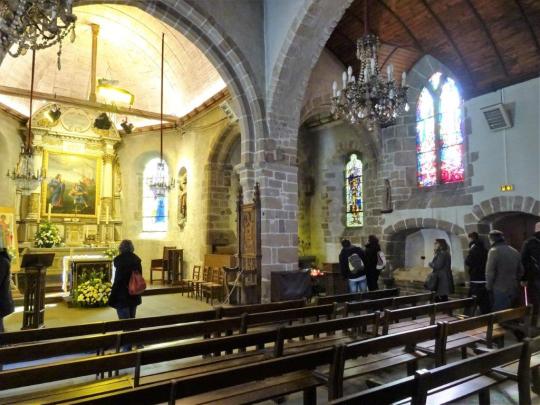
The nave and altar of Église St-Pierre
The church dates back to the first days of Christianity on the mount and is the church of Saint Michael Sanctuary. It must have been a poor cousin to those upstairs as the altar and the statue of St. Michael were given as hand me downs at the end of the nineteenth century.
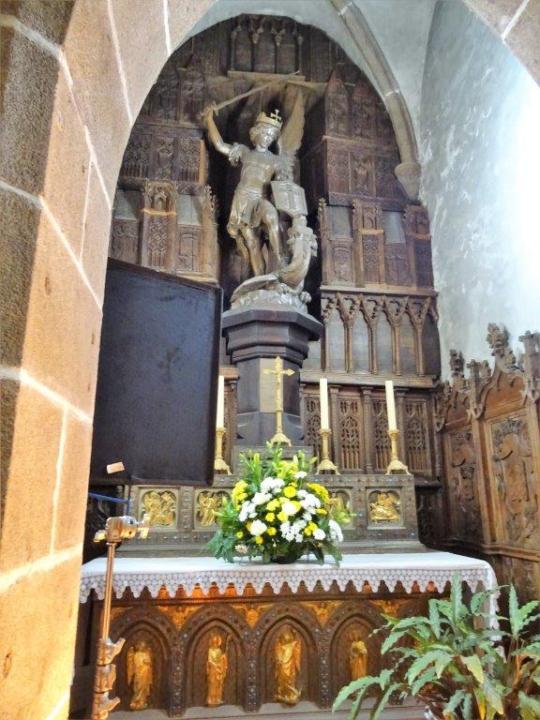
Saint Michael slaying the dragon.
After a brief but interesting sojourn we pushed back out the door and headed up the stairs toward the abbey. As le Grande rue was cut off at the church the only way up was to climb a narrow stairway that was cast under the churches altar next to the street. It took us up several more flights of stairs and delivered us to the churches bell tower and graveyard. Both, like Église St-Pierre, small and interesting.

Looking back down le Grande rue. Stairs to the graveyard on the right

Graveyard from above
Very neat was the first impressions when entering and walking amongst the graves. There weren’t a lot in here but not many live here either, and mostly recent departures (on a medieval timescale). There were definitely more gulls in the area than people.
We kept climbing, up and up, passing a steep ramp where goods were initially hauled up on trolleys by muscle and pulley systems. Good old pilgrims and monks, only work and pray. They must have dragged some heavy stuff up that ramp.
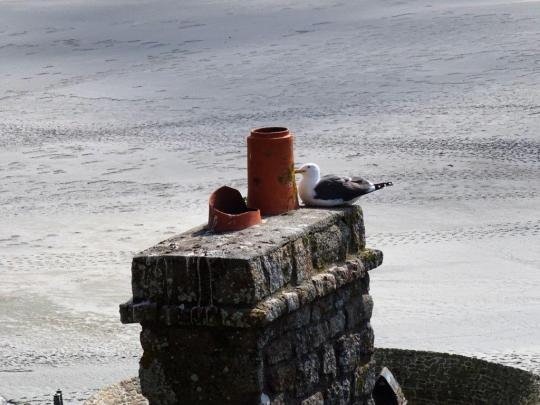
A local
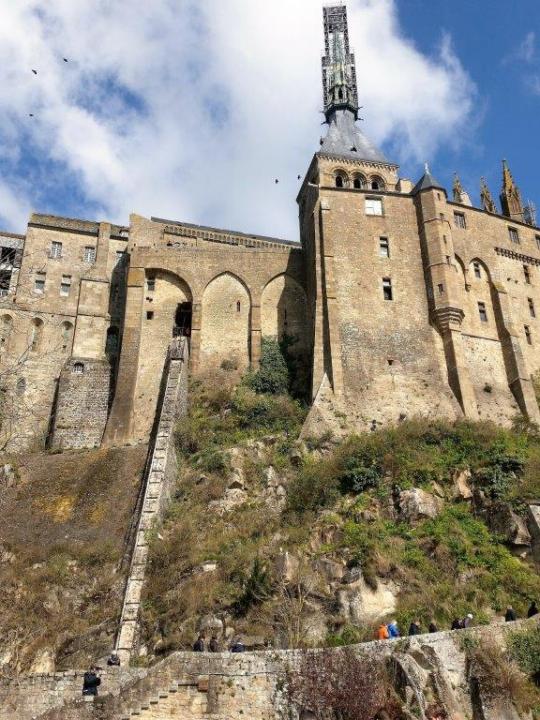
Goods ramp up to the abbey
A little further on and we were in de la Salle des Gardes, paying the nine Euro each for admission to the abbey. With few people queuing the whole process didn’t take long including buying time on the audio tour. Ten minutes after entering through security we were heading toward the abbey entrance. Leaving de la Salle des Gardes we headed upward, twisting and turning up the Grand Degré, its course predetermined being sandwiched between the church choir on the right and the monks’ quarters on the left. Climbing the ninety or so steps to the terrace above was interesting to say the least.
We firstly passed under an uncovered stone footbridge that linked the abbot’s quarters to la Crypte des Gros Piliers. Shortly after passing under the covered timber footbridge connecting the abbot's residence to the south transept of the abbey church.
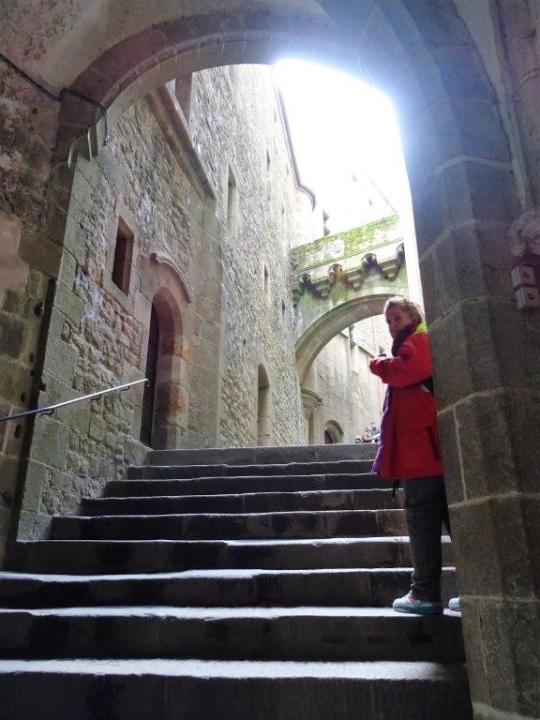
Climbing the Grand Degré, stone footbridge above
The climb to the top was a little strenuous but not much. We didn’t exactly know where we were going, just where the audio told us but we ended up on a terrace at the top, known as Saut-Gaultier and apparently named after prisoner sculptor threw himself over the side after criticisms of his work. On the way up to the terrace there was an opportunity for Zac and Soph to play around with an oversized tap, which of course they did.

It looks like fun but rather a recipe for an argument
When we arrived at the top there were people everywhere, enjoying the view or just lounging around. So much so that we had to manoeuvre around them sitting all over the stairs and push our way to the edge. Fantastic view everywhere but after a short while we had to move on.
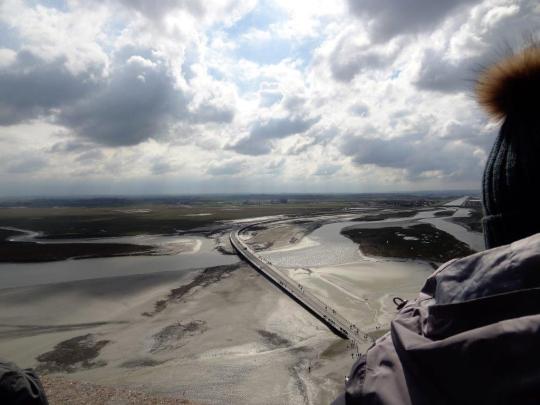
View to the South
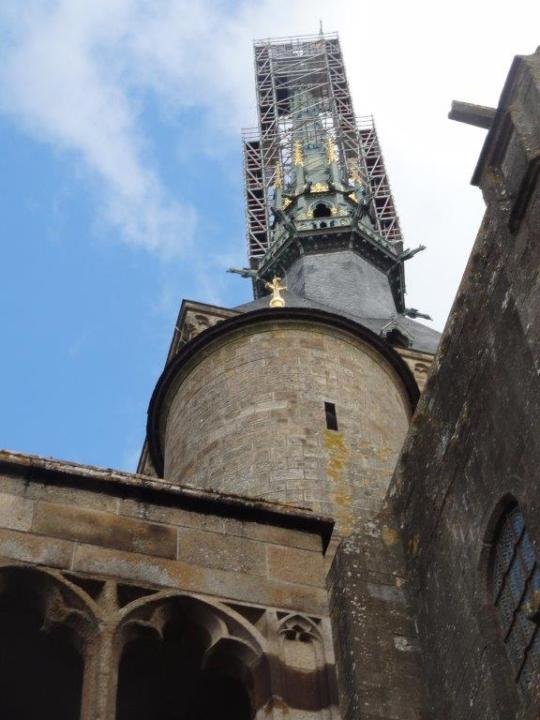
View of the spire (under repair)

View back down the Grand Degré, timber footbridge above joining the abbot’s residence to the southern arm of the transept. The crypt of Saint Martin forms the foundation below
Moving into the abbey church we immediately veered left and out onto the west terrace, formed during the eighteenth century following a fire that destroyed the parvis and the first three bays of the nave. The classical façade was rebuilt and the terrace created. Half of the terrace was barricaded off by temporary fencing filled with scaffolding intended for repairs higher up. The other half dealt with the tourists so it was cosy. Easily recognisable by the step in the terrace floor was the outline of the original part of the church lost to the fire. We had to watch our step with the crowd and the views diverting our attention to the horizon as to trip wouldn’t be difficult. All in all, we managed and took it all in before moving on.
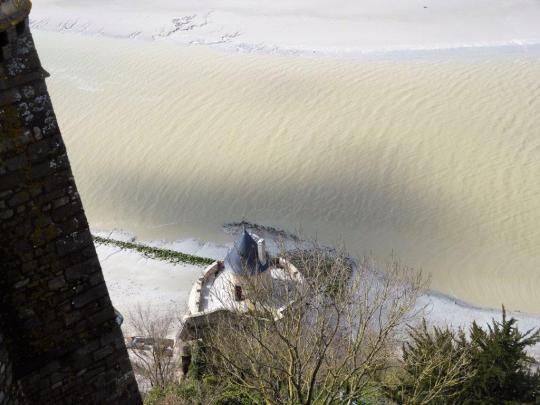
Looking down at Tour Gabriel built in the 1530’s, a square defensive bastion of several storeys that was used for defence. The seventeenth century turret was meant for a windmill which never eventuated

View of the Cloister, founded on the Knights’ Hall and wine cellar below
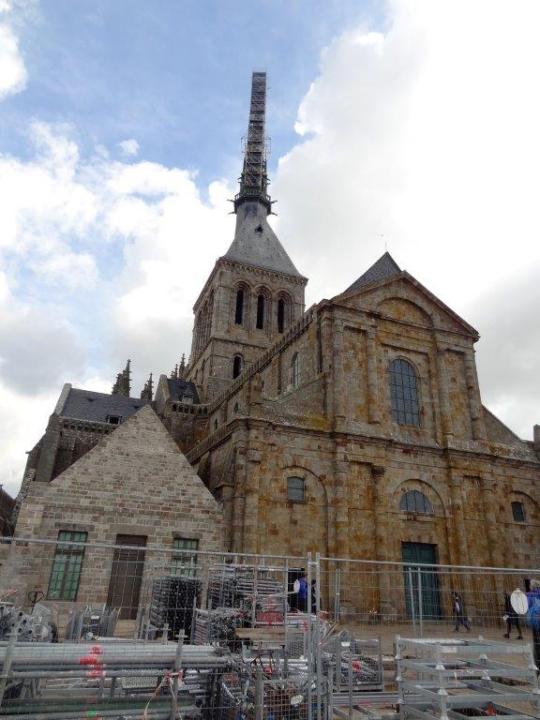
Scaffold storage on the west terrace
Back through the façade and into the nave of the abbey. A service was underway not far away so we walked about looking around in silence. The choir was cordoned off due to the service so we veered left and headed outdoors again and into the gardens of the cloister.

Parishioners and tourists alike attend the service
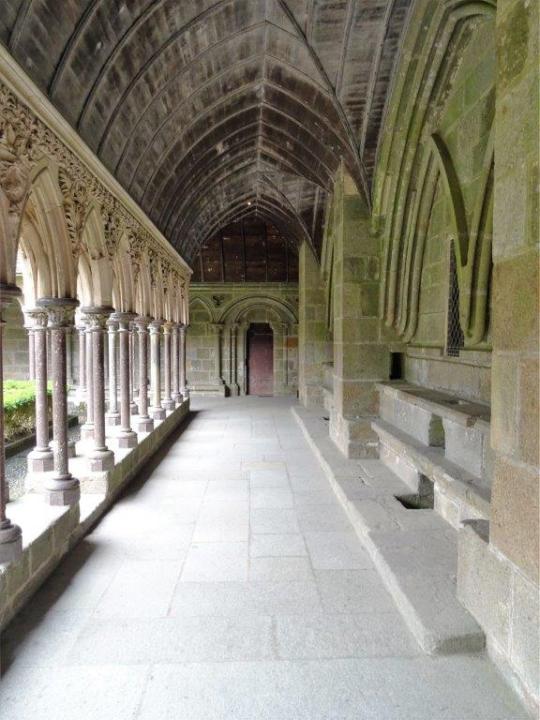
First impressions of the Cloister, Impressive
The Cloister along with the Refectory form the top part of la Merveille, the thirteenth century” Wonder” that faces the Chausey Islands to the north.
As a consequence of Mont St-Michel’s pyramidal profile, the builders had to effectively wrap the buildings around the steep rocky slope. Almost all of the original buildings have long since disappeared with the Romanesque abbey built on top. Although the end of the nave, where it meets the transept sat on the tip of the Mount, the actual north and south arms of the transept were supported by the crypts. The nave itself was constructed on top of the old pre-Romanesque church.
A long narrow aisle was built at ground level and is occupied by the Almonry to the east, where the monks welcomed the poor and pilgrims from all walks of life (bet they weren’t allowed any higher) and the Cellier or monks’ store room to the west, also acting as a buttress. Above the ground floor, two more storeys were constructed, Chapter house and Salle des Chevaliers on the second floor supporting the Refectory and Cloisters above. The whole building acts as support for the eighty-metre-long abbey.

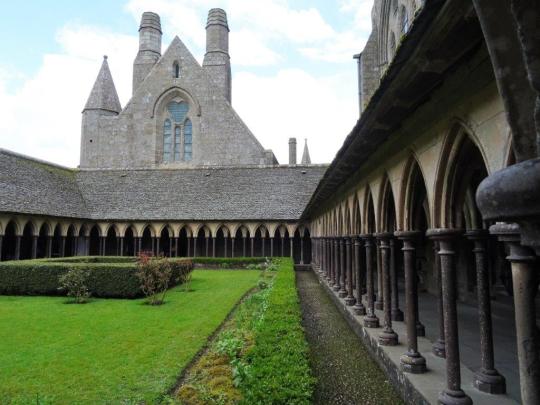
View of the Refectory

View of the Abbey church
The Refectory was built in 1225 and was the dining hall of the monks. As we walked in from the Cloister, only two windows were apparent in the far wall. All in all, there were fifty-nine windows, mostly located in the side walls hidden by the slender but deep columns which by design allowed maximum light into the hall. The curved arches above these windows supported the vaulted ceiling of curved beams.
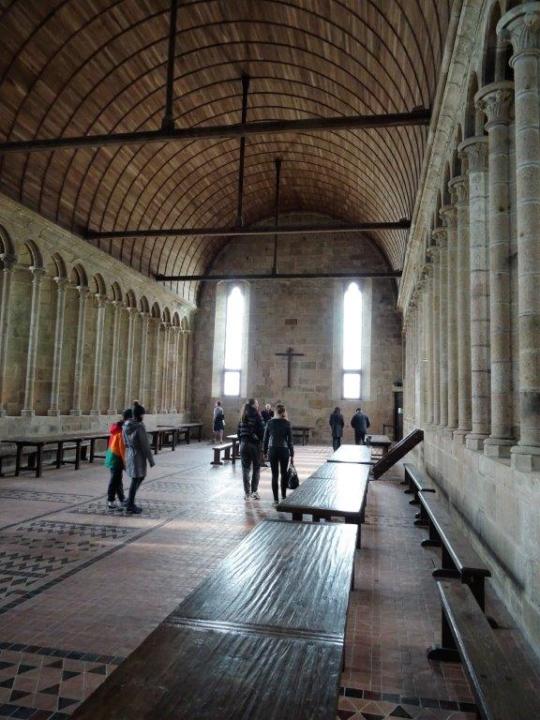
The Refectory
From the refectory, we headed down a couple of flights of stairs to the Guests Room or La Salle des Hôtes which was characterised by its slender pillars supporting a pointed arch design and capitals adorned with flowers. The large windows in the side walls would have provided ample light for the important guests who would have visited. The two huge, solidly built fireplaces in the end wall were specific for cooking the huge meals that must have happened on occasion. It was somewhat dizzying to stand within the fireplaces, wrench one’s neck back and look up the tall chimney shafts.
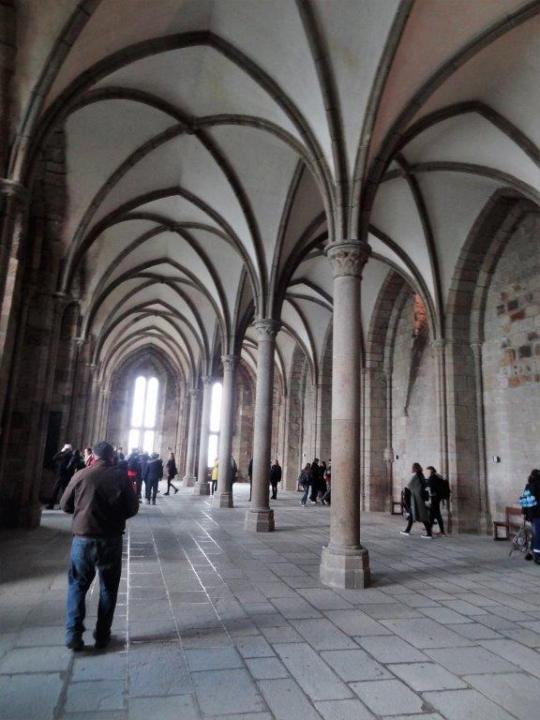
La Salle des Hôtes

Where all of the cooking went on
Once we were finished in la Salle des Hôtes, and we spent a bit of time there, we climbed the stairs to la Crypte des Gros Piliers, with massive five metre circumference columns. The Crypt of Saint-Martin along with the Romanesque choir combined to support the Southern Transept above. During the Hundred Years War, Mont St-Michel’s fortifications were strengthened but in 1421 the Romanesque choir collapsed. Crypte des Gros Piliers replaced it and together with the Crypt of Saint-Martin would eventually house two huge cisterns to store 1200 tons of water after the Spring of St-Aubert dried up. Piped to tanks in the Cloisters, the cisterns were continually topped up with rain water from the vast roof area above.
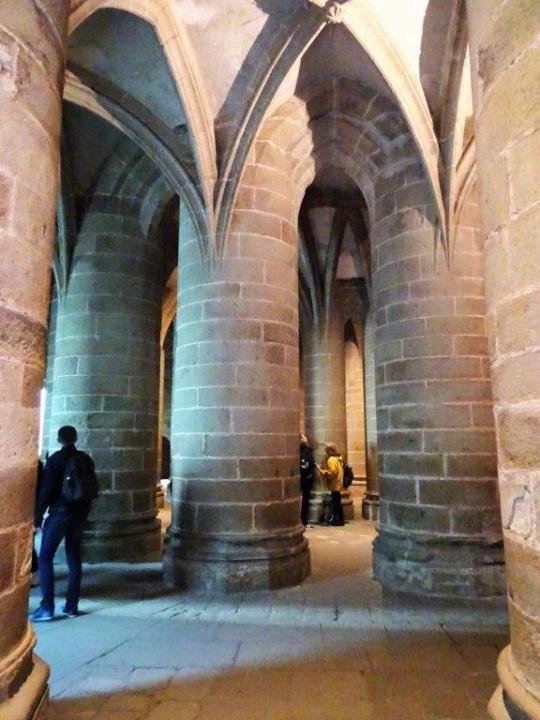
The Crypte des Gros Piliers replaced the Romanesque choir
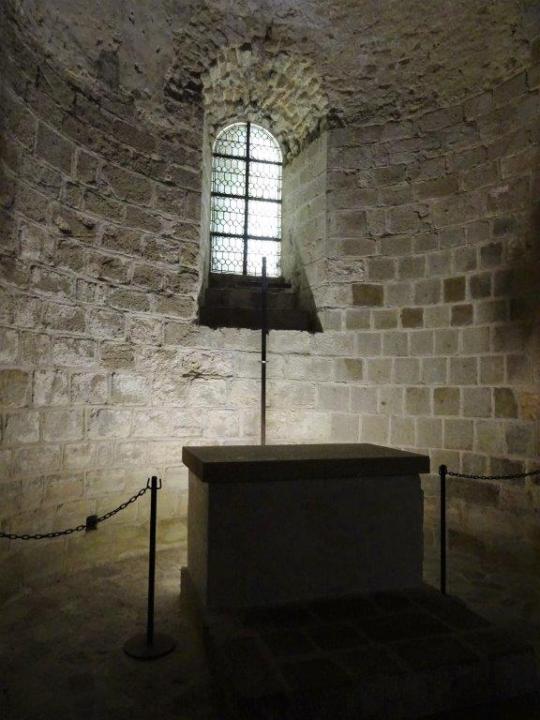
Crypt of Saint-Martin as it is today
We then moved through a narrow passage and onto the Monks’ Ossuary, so called (according to Rick Steves) due to the size of the graveyard necessitating the frequent recycling of corpses. Once dug back up the bones were stored here. Naturally it also housed the hospital and morgue.
The central feature of this area was the large “hampster type” Prisoners’ Wheel that was installed directly below Saut-Gaultier Terrace during the revolution and after the island was turned into a prison. The first three hundred prisoners were monks that refused to renounce their vows. Teams of prisoners took turn on the wheel lifting goods and building materials that were bound to the trolley up the steep ramp.

The Prisoners’ Wheel

The ramp from the top

The wheeled goods trolley
After the amusement and intrigue of the wheel was over we moved on through the Promenoir des moines to Salle Des Chevaliers (Knight’s Hall) and to again marvel at the beauty of the architecture before us. Also called the scriptorium, the hall was thought to have been the place where monks produced and illuminated manuscripts. It would seem however, that it was only used for reading and studying. The Knights Hall comes from the Order of Saint Michael, initiated by Louis XI in 1469 as a French chivalric order. The idea was that knights met yearly at Mont Saint-Michel but due to its isolation the plan was deemed impractical and the whole idea fell by the wayside.
Built to hold up the Cloister, Salle Des Chevaliers was divided by three rows of cylindrical columns with carved capitals and vaulted ceilings. The room features two huge fireplaces with canopies that reach these ceilings. The overall arrangement belied its size and portrayed the perception of a hall vaster than reality.
We were about to vacate the building and the best was saved for last.

The huge fireplace and canopy of Salle Des Chevaliers
Leaving the hall, we moved down through the gift shop and out into the gardens. From here we could get a good perspective of the immensity of la Merveille from below and appreciate the effort and skill required to construct such a building almost a thousand years ago. The view from the gardens was great, looking out over the sea to the north. Moving along the line of buttresses, we found ourselves at the end of the gardens and about to head back to the entrance.
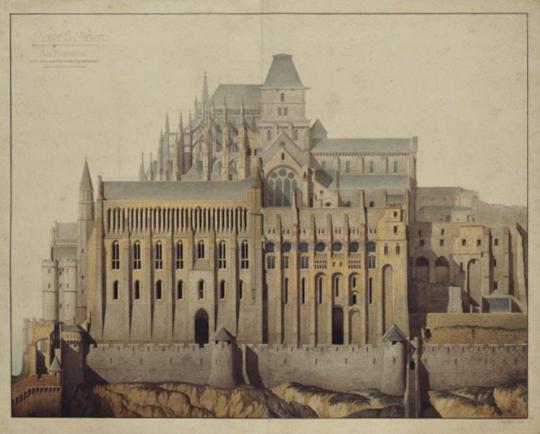
"Mont St Michel, la Merveille et ses dépendances dans leur état primitif" by Émile Sagot
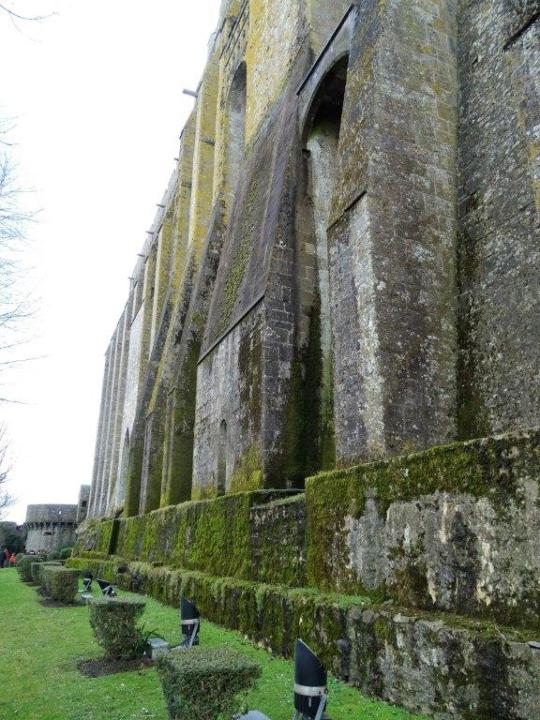
La Merveille buttresses from the gardens
Once we moved away from the gardens at the base of the La Merveille, we entered the ramparts, at Tour Claudine and descended around to Tour du Nord and further along the guards' walk towards Tour Boucle.
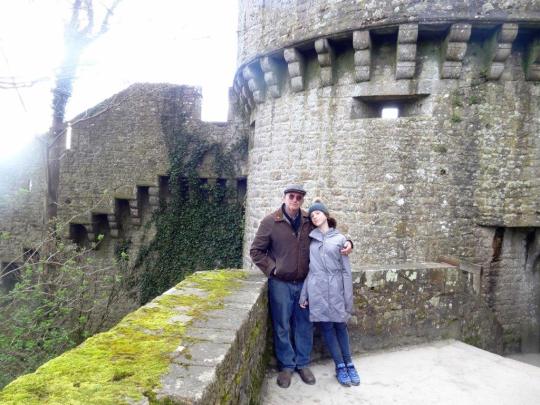
Dad loves Soph. Tour Claudine and the start of the curtain wall
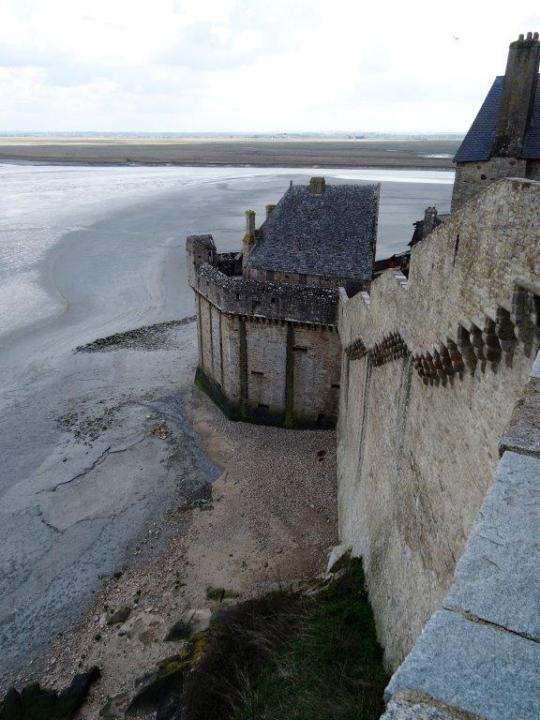
Looking down at Tour Boucle
We were in two modes by now, leaving mode and eating mode. On the way down we stopped several time on the ramparts, firstly to look for food as the top of the rampart was effectively at Grande rue street level so the restaurants and shops connected the two and secondly, to by some souvenirs at a little shop near one of the towers. We ended up buying the souvenirs but skipped the food and headed back to the car. This time all on the shuttle.
The whole experience was excellent even if we didn’t see the lot. Work was underway here and there which precluded us from seeing some things such as the Escalier de Dentelle (Lace Staircase) to the top of the abbey. Maybe another time.
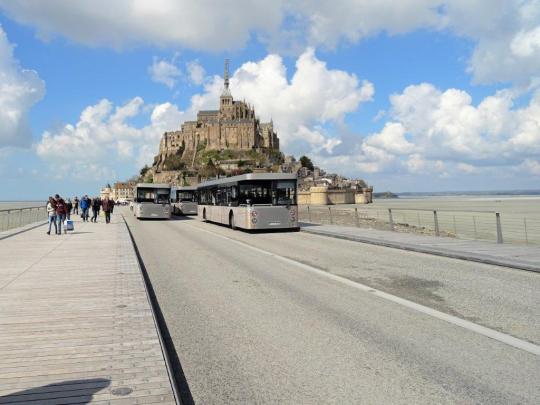
Waiting for the shuttle back to the car
Back in the car we planned to travel back to Dinan via Saint Malo almost fifty kilometres to the west. The navigation was set to the coast road so we hugged the coastline for a couple of hours, heading inland at Saint-Benoît-des-Ondes. We had nothing but snacks all day so were looking for a feed once we got there.

Sand yachts for hire at Hirel
Soon enough we were entering St-Malo and once we were on Avenue Louis Martin we were taken straight through the industrial area and almost up to the front gates. There were people everywhere and nowhere to park. There were plenty of car parking areas but not much available. We at first turned left as cars were parked everywhere and there must have been some spots left but to no avail. At the end of Quai St-Louis we hit a roundabout and were heading back, frustrated, to where we started. We then turned right and looked for something further out but it was no parking everywhere. We turned around again and headed back toward the city. Low and behold we were driving past an underground carpark straight out the front of the main gates. In we went and parks a plenty.
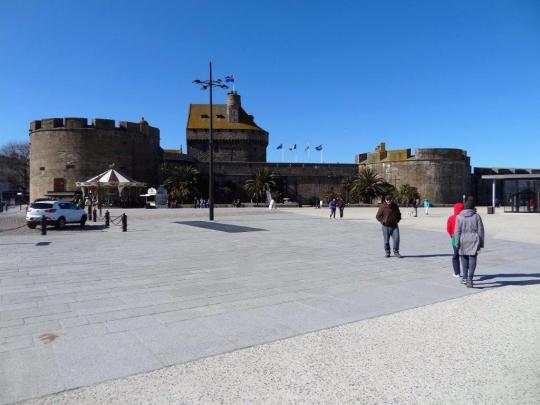
First impressions. Chateau de St-Malo doubles as the town hall and houses the Museum of St-Malo.
St-Malo, founded during the first century by Gauls, was actually located just south of where it stands today at what is called St-Servan. During the fourth century the Romans further fortified the town with the fort at Aleth, part of the Saxon Shore promontory fort system that existed on both sides of the English Channel at the time and protected the estuary of le Rance from seafaring enemy raiders. During the sixth century Irish monks Brendon and Aaron established a monastery nearby and the small outcrop to the north was named Maclou, Mac’h Low, or Malo after a Welshman who accompanied Brendon on one of his journeys.
A narrow strip of sand that was the only access to the rock by land was a natural defence and attracted the people of Aleth to move there to try and avoid Viking raids. The trail, le Sillon, consisted of dunes occupied by windmills. The ramparts were built during the twelfth century and the granite dyke was built over decades from the late nineteenth century until the early twentieth.

Old map of St-Malo showing le Sillon connecting the citadel to the town of Paramé, now a district of St-Malo

Porte St-Vincent, built in 1708, is the main entrance to the citadel.
Having admired the entry gates, we moved through and into Rue St-Vincent until we could go no further and then left into Rue Porcon de la Barbinais. A few small deviations and we ended up window shopping towards Porte de Dinan. We never went through the gate and out toward the port entrance but took the stairs to the right and ended up on the ramparts above. We proceeded slowly from here taking in the sites on both sides of the wall. To the left was the port entrance, protected by Môle des Noires, made up of wharves where the ferries to Great Britain were moored as well as a lock that allowed access to Bassin Vauban and the marina. To the right was the reconstructed city buildings all but destroyed during World War Two.
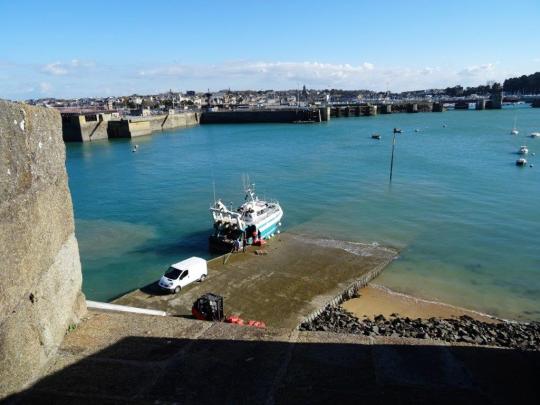
The port entrance where ferries leave for Great Britain
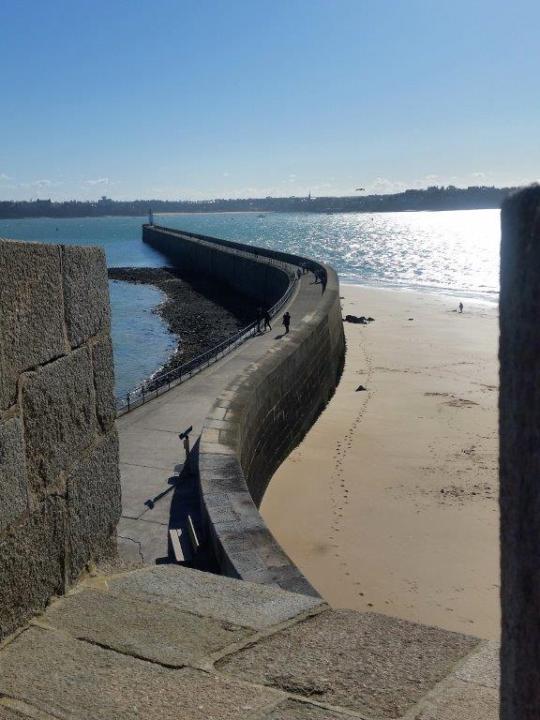
The Môle des Noires, the long curved breakwater named after the rocks on which it sits (Roches Noires)
The reconstruction of St-Malo was undertaken over a twelve-year period (1948-60) after its destruction in 1944. After the D Day landings, the Americans swept through Brittany encountering several fortresses similar to that of St-Malo, fortresses that the Germans didn’t want to give up. The Americans believed there were thousands of Germans within the city but there were only about seventy along with several hundred locals who were stuck after the Germans shut the gates so after head Nazi Colonel von Auloch notified the Allied commander that he would never surrender, he started a fifteen-day bombing campaign that would end in practically the total destruction of the old city. Only 182 of the original 865 historic building were still standing by the time von Auloch and his offsiders did surrender.

What was left after the bombing

What’s there today

We wandered the ramparts enjoying the lovely buildings Intra-Muros as well as the coastal views. We still hadn’t had a decent feed for the day and it was dinner time. We had walked well along the walls above Plage du Môle and happened across Le Corps de Garde crêperie straight across from the local ocean baths. The pool itself looked inviting, for a wander down but, not a swim. We settled inside the crêperie out of the weather and had a drink and some tucker. Jo was still quite ill with her chest infection and was looking worst for wear. She needed a break. We wouldn’t have been surprised if she had pneumonia but she would not seek medical attention in case she was put into hospital, effectively ruining our holiday. Trooper.

Le Corps de Garde straight ahead. Great food

Local ocean pool
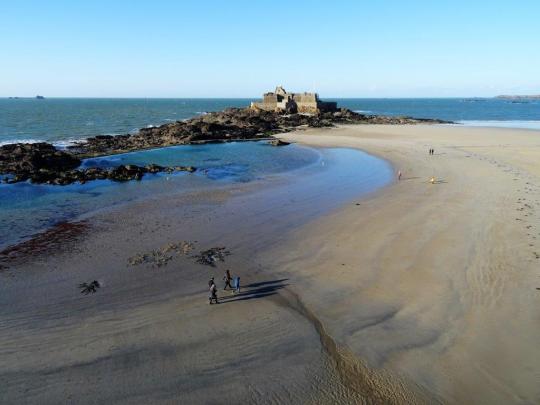
Fort National, the residence for a while for all the men between 16 and 60 in the city, interned after a skirmish with the Germans one night. The historic fort is on an islet near the castle and only accessible at low tide
Notorious for being the home of swashbuckling corsairs, St-Malo’s privateers were sanctioned by the French Crown to perform raids on the shipping of nations at war with France. The vessels and cargo were seized and sold at auction with the corsair captain getting a cut. The town also experienced great prosperity during the seventeenth and eighteenth centuries with the ships bound for the Indies, China, Africa and the Americas being fitted out by the local tradesmen.

Robert Surcouf, the French privateer who spent two stints raiding ships in the Indian Ocean between 1789 and 1808. He captured over 40 “prizes”, also accruing a large fortune as a ship-owner, both from privateering and business dealings.
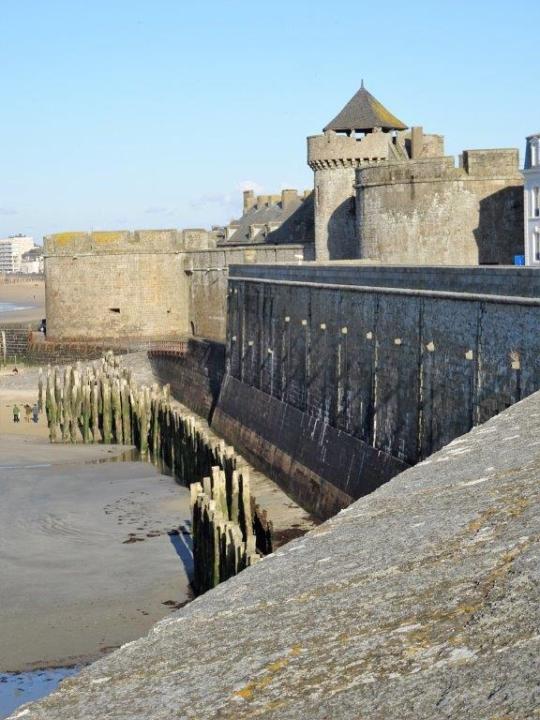
The sea wall adjacent to Chateau de St-Malo
We dropped off the wall back near the Chateau de St-Malo. Nearly seven, everyone was tired and it was time for home. We headed back to the car and then back to Dinan for an early night’s sleep. For tomorrow, we’ll head to the beach.
0 notes
Link
BARRON'S PENTA How a Child of Wealth Became a Drug Addict How a child of affluence became addicted to opioids and lost everything but her life. Email Print 4 Comments Order Reprints Facebook Twitter Google+ smaller Larger By CARA COSLOW June 16, 2017 8:43 p.m. ET Cara Coslow, drug-free for seven years, came clean only after she lost her entire fortune. Shayan Asgharnia I am a recovering opioid addict. I once went to the dentist because of an infected tooth, a common occurrence normally treated by antibiotics. Instead, I persuaded the dentist to pull three perfectly good teeth in order to get one prescription of 30 Vicodin—taken in a single dose before I’d even left the pharmacy. I was so addicted to Vicodin that I needed a constant level of opioid in my system just to function, and I kept myself going in four-hour increments. Three teeth seemed a small price to pay. I come from an affluent family. My father, Sam Coslow, was a composer and movie producer who won an Academy Award for producing the 1943 short film Heavenly Music. He followed his early show-business career with a more lucrative career in finance, after founding a stock market newsletter called Indicator Digest. I had a beautiful and witty mother, Frances King, who had parlayed her opera training into a cabaret act during New York’s Cafe Society era, regularly performing at the Manhattan restaurant One Fifth Avenue. I grew up in beautiful homes in Miami and Bronxville, N.Y.; spent my summers in London and Florence; and got an undergraduate degree in English from Sarah Lawrence College. I was not supposed to end up a drug addict. If you, your child, or spouse has a drug problem, know that your family is not alone. A scourge is upon our country. Nintey-one people a day die from opioid overdoses, almost quadruple the rate in 1999, calculates the Centers for Disease Control and Prevention. That means 300,000 Americans died from opioid overdoses from 1999 to 2015, with middle-age adults being the most vulnerable. President Donald Trump has just ordered a special opioid-crisis commission. Many consider this to be the worst drug crisis the country has ever known. Now, looking back, I see there were some early red flags. I had been a panicky child, plagued by a severe case of separation anxiety from my mother. This was the 1960s: A bit of tranquilizer was considered a good way to get me to school. By the time I was in my late teens, I was addicted to downers. Cocaine and booze followed, but I found the 12 steps and stayed sober for many years, until the pressures of my budding Hollywood career produced a series of headaches. My opioid addiction began with a single prescription for Vicodin, prescribed for my migraines. I was in my early 30s and head of casting at Carsey-Werner, one of the most successful television-production companies ever. I oversaw the casting of Roseanne, Cosby, and That ’70s Show. I was nominated for an Emmy and discovered Ashton Kutcher. I had all of the material prizes: a six-figure salary, a companypaid $100,000 car, and a beautiful home in Encino, Calif., which I spent a year meticulously renovating. Coslow was a panicky girl and given a bit of tranquilizer to get her to school. Cara Coslow I had no idea that these drugs, prescribed for legitimate pain, would end up taking everything but my life. I liked the way they made me feel. Vicodin was the best antidepressant I’d ever known. These pills gave me energy and spunk. They gave me the qualities I wanted but couldn’t manufacture on my own. I went from filling these prescriptions monthly, to twice monthly, to weekly, to doctor-shopping to come up with a prescription for 30 pills every day—the amount I needed to function. The opioids no longer made me feel good; without them, I suffered almost unmanageable pain. It felt as though I had tiny coal miners with tiny pickaxes living in the center of my bones and scraping to get out. I’d sweat profusely, have diarrhea, and vomit. So I endured surgeries and injuries and tooth extractions for the next handful of pills. Opioid withdrawal is a pain like no other—it will bring the toughest stevedore to his knees. By 2000, I was putting in only brief appearances at work. My days instead were spent going from the emergency room to urgent care and from doctor to dentist in an ever-widening radius. You couldn’t see the same doctors too often, or they’d know you were seeking drugs. I faked injuries or inflicted them on myself, and ran an elaborate con game on the medical community. Glancing at a photograph of a teen behind a doctor’s desk, I’d say, “Is that a photo of your son? Why, he’s good-looking. Has he ever thought of…acting?” I’d practically promise to make the kid a star. I awoke one Christmas morning in acute withdrawal, desperately needing more pills. I was due to spend the day with friends and their child, whom I adored. But by then, I had used up all of the neighborhood medical facilities and was seeking drugs on the outskirts of town, at shabby clinics that needed my cash. But because it was Christmas, I bolted to an emergency room in Malibu—something more festive with a view of the ocean. I was very sick when I got there. I’d learned from a doctor, who was also an addict, how to fake an embolism or a heart attack and ensure my place at the front of the ER line. But that amount of drama was pointless. I needed to get in and out for Christmas dinner. I got 10 Vicodin—not enough to get me out of withdrawal. I went to dinner, sat there in misery, and as soon as it was done, I was out the door to an urgent-care facility in El Segundo. Again, I got a dose too small to relieve the pain.So, I burst into my third ER, at a proper hospital, complaining of chest pains, sweats, and other coronary symptoms, a couple of them genuine. It didn’t matter that this was Christmas; I’d been living the same day for the past several years. Only with a shot of Demerol, administered at midnight, was I finally able to sleep. The nightmare lasted for 10 years. Along the way, I lost my entire fortune—my jewelry, my furniture, my 401(k), my art, and the collection of letters written by Colette, George Sand, and Victor Hugo that I’d purchased in a small store on the Rue du Bac in Paris. I literally lost millions of dollars, some of it in future earnings but most from the compromised logic of a drug-addled brain, like quitting my six-figure dream job and walking away from property I had invested heavily in. But it’s also important to note that I got hooked on these pills in the late 1990s—a crucial time in the history of this crisis. Suddenly, opioid medications, which had been used primarily and legitimately for acute pain that came from injuries, surgeries, or palliative care, were being prescribed liberally. In Drug Dealer, MD, Dr. Anna Lembke describes the influence of Big Pharma on the prolific prescribing of pain meds that started in the ’90s. Companies like Purdue, the manufacturer of OxyContin, funded lectures, conferences, and research that promoted the use of these drugs for nonacute pain. From 1999 to 2009, I tried to get clean some 20 times, including checking in and out of 10 acute detox wards and rehab centers, the rest at home with nurses and doctors. I couldn’t stay off the drugs. The postacute phase of detox was so miserable that I invariably went back to opioids. I tried methadone and found I couldn’t function on it. I nodded out. Too zonked to make good casting decisions, I was excluded from important meetings at work. Too ashamed to tell my bosses how much I needed help, I asked to be let out of my contract. Later, I tried Suboxone, the other drug substitute used in medication-assisted treatment. But I also abused it, never sticking to the prescribed dose. If getting off opioids is an uphill climb, getting off replacement meds is Hillary Step, Mount Everest’s nearly vertical rock face. The withdrawal from methadone and Suboxone is torturous, protracted, and next to impossible. The only time I ever came close to dying from drugs was when a detox doctor told me to stop taking methadone three days before he would perform an idiotic, highly dangerous “ultrarapid detox” procedure. It was neither rapid nor a detox. The third day off methadone, I was found almost unconscious on my guest-room floor after enduring the nearly unendurable pain of methadone withdrawal. At the hospital, I had to be administered drugs intravenously in the lobby—my blood pressure was too high even for transportation to a room. Methadone withdrawal is responsible for many documented deaths. If your loved one is hooked on opioids, please find a doctor who really understands opioid withdrawal. Then, right before another Christmas in 2009, I got lucky. I met Dr. Mark Honzel during my frequent stays in the acute detox ward of Brotman Medical Center in Culver City. He was the big doctor there, and he intimidated me. He was a no-nonsense German, and I was self-important. We butted heads, and he made me cry. But, by this point, I was living half a life, with no career and very little money. Recovery was my only real option, and I knew Honzel was the one doctor I could trust. I had overheard him tell someone that methadone withdrawal is one of the hardest there is—no other doctor I knew had copped to that. On Christmas Eve, he admitted me once again to Brotman. After two weeks, my insurance stopped paying for the detox. Honzel said it was impossible for me to go home. I needed longer-care treatment, but my insurance wouldn’t cover rehab. Honzel had started working with a new rehab center in West Hollywood called Klean, a small and elegant facility close to my condo that would allow me to bring my dog Saffron, my companion who had ridden out 15 years of my ups and downs. But I was flat broke and I knew that treatment in private rehab facilities costs between $30,000 and $100,000 a month. Honzel arranged for me to get a Klean scholarship. At Klean, I was looked after by a loving and nonjudgmental staff and wasn’t forced to continuously walk in the deserts near Palm Springs, as I had been at the Betty Ford Center. I stayed at Klean for three months. It was my route out, but there are, of course, other wonderful facilities around the country. If you need help finding a clinic near you, go to samhsa.gov, the Substance Abuse and Mental Health Service Administration website, and type in your address. A range of facilities for all levels of care will pop up. But if you or your loved one is trying to kick the habit, know that there are no shortcuts to getting off opioids. You just have to soldier through it. Because I had spent so long on Suboxone, it took over a year to get my energy up and even longer to feel OK in my skin. Honzel told me, “In my experience, relapse rates with opiate addiction are about 90% one year after abstinence-based treatment. It’s significantly better with medication-assisted treatment, but MAT is not right for everyone, and each patient has to be individually assessed.” I was one of those patients who couldn’t stay on MAT without abusing it, but ultimately I fell into the 10% who remained off all drugs. And now I am paying my blessings forward, working as an intake administrator for Klean, guiding addicts through the treatment process, and telling them what to expect. I haven’t taken a mood-altering chemical since I left. It has been more than seven years. It’s a different life than I had. A better life—to be sure. E-mail: [email protected]
0 notes
Text
Les Miserables filming locations: where the BBC series was filmed – and how to visit
The beautiful locations featured in the new BBC adaptation might surprise you
Belgium is the real star of Les Misérables. Not a single scene from the BBC’s epic adaptation of Victor Hugo’s classic novel was shot in Paris, and very little was filmed in France.
Dominic West, who plays Jean Valjean, and his co-stars spent six months touring Belgium’s historic towns and villages. “It’s a story on the move and of the people, so you want to film on the street as much as you possibly can, which is pretty challenging,” says producer Chris Carey.
“It’s a lot easier to shoot in a studio rather than to invade different parts of Belgium, but it was very important to our director that we were outside as much as possible.”
Brussels
Belgium’s French-speaking capital has several cameos. When Baron Pontmercy pays his father-in-law a visit in episode one, he is strolling down Rue du Peuplier in the shadow of the mighty Beguinage Church, a 17th century Baroque church in the heart of the city.
Look out for a grand arch looming over a square where a funeral procession takes place in a later episode. This arc de triomphe is in Cinquantenaire, a park dotted with museums in Brussels’ European quarter. “We needed somewhere monumental and massive for that moment. It’s more of a semi-circle actually, but come the revolution it’ll look like a square,” says Carey.
Monsieur Gillenormand’s apartment is an antiques shop called Costermans on Place du Grand Sablon 5. “We had to be extremely careful because they have a lot of very precious antiques that we’d have had to pay for if we’d broken them.”
Why go?
There’s more to Brussels than politics and bureaucracy. Admire the flamboyant Flemish guildhouses that line its Grand Place, visit the elegant home of the inventor of Art Nouveau, Victor Horta and explore the thriving contemporary art scene. Indulge in great beer, waffles, double-fried frites and Belgium’s famous chocolates.
Around Brussels
The production team spent three weeks at Enghien Castle, which doubled up as a police station, the convent and Valjean’s safehouse, among other things.
They also did some time in a former jail in Vilvoorde, a town north of the city. “It doesn’t look much from the outside, but inside there’s an 18th century prison. It’s horrible,” says Carey.
Why go?
Surprise your family by informing them you’ve spent a night in jail: The Lodge is a hotel with a spa located in part of Vilvoorde’s old prison. The rooms are stylish and spacious these days. Enghien’s beautiful landscaped gardens are open to the public and include a dahlia garden and one with over 800 varieties of roses.
Limbourg
“We spent an incredibly cold week there last February,” says Carey. “It’s a stunning place. We had to do almost nothing to it apart from take out some modern piping and electrical wires, and bring in some fake snow.
Why go?
You can choose from more than a hundred beers and tuck into a regional speciality like calf’s head at Brasserie St-Georges, an old-world bistro in the cobbled square. There’s an art gallery in the old town hall, Espace Arvo.
Ghent
Belgium’s best kept secret – the city of Ghent – stood in for Paris. In episode four, you’ll see civil unrest taking place under its bridges, although the buildings no longer have their distinctive stepped gables; the CGI team replaced them because they looked too Flemish.
Why go?
This medieval city has a 12th-century fortress with panoramic views, fantastic museums and the Holy Food Market – a chapel that’s now a temple to gastronomy.
Namur
The production crew owned a bridge for a night in the capital of Belgium’s French-speaking region, Wallonia, which is the setting for a dramatic scene involving Javert.
Namur is crowned by one of Europe’s largest fortresses, but its biggest claim to fame is being the birthplace of French fries. The story goes that the Namurois loved to eat fried fish. When the river froze during a harsh winter, they decided to cut up potato in the shape of fish and fry them instead.
Why go?
With its charming museums, snug restaurants and vintage shops, Namur’s old town is a lovely place to while away a couple of days. There are superb views from the citadel and you can take a boat trip down the River Meuse.
The French locations
Sedan
Most of the Paris scenes were filmed in Sedan, a town a few miles from the Belgian border in north-east France. “No one’s heard of Sedan, but it’s an unbelievably beautiful town with a massive old fort in the middle of it,” says Carey. “I’d really encourage people to visit.”
The fort doubled as Toulon, where Valjean serves the end of his sentence in episode one, while Sedan’s streets were transformed into the barricades in episodes five and six. “The people of Sedan were amazing. They let us caper about with hundreds of extras, shooting guns and firing cannons at all hours of the day and night.”
Why go?
This tranquil town has a colourful history thanks to its precarious location; Napoleon III and 100,000 of his troops were taken prisoner here during the Franco-Prussian War. Part of the vast fort – one of the largest in Europe – has been converted into luxury accommodation, Hotel Le Chateau Fort.
Marville
This Renaissance village stood in for Digne, where Valjean gets work hauling barrels in episode one and encounters a wise bishop. It’s only an hour’s drive from Sedan and six miles from the Belgian border.
Why go?
Marville has been voted one of France’s favourite villages. Admire the wealthy merchants’ houses from the 16th and 17th century, then stroll around their ornate tombs in its atmospheric cemetery Saint-Hilaire.
(x)
#les mis bbc#bbc les mis#chris carey#articles#shooting#locations#Brussels#Limbourg#ghent#Namur#sedan#marville
10 notes
·
View notes